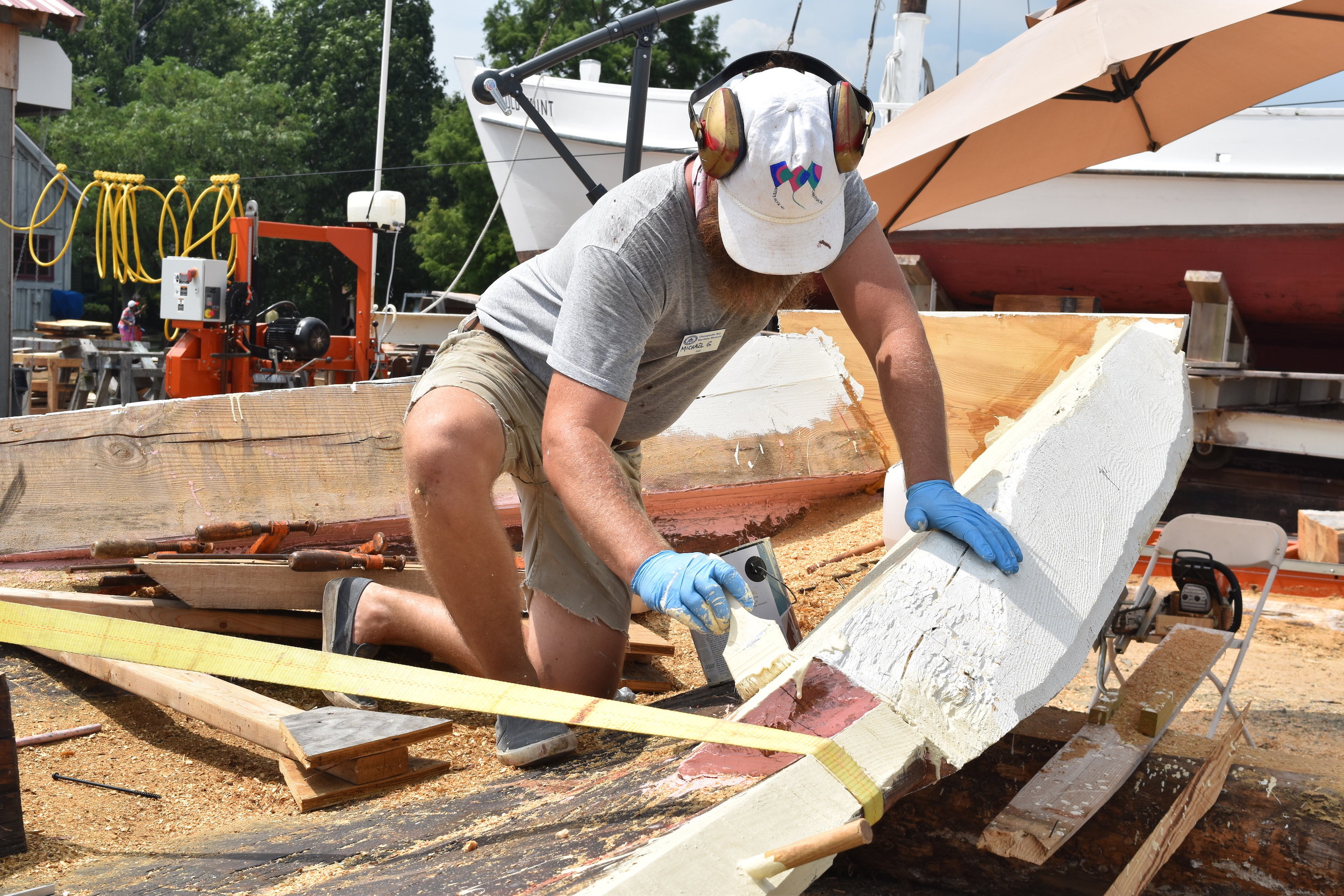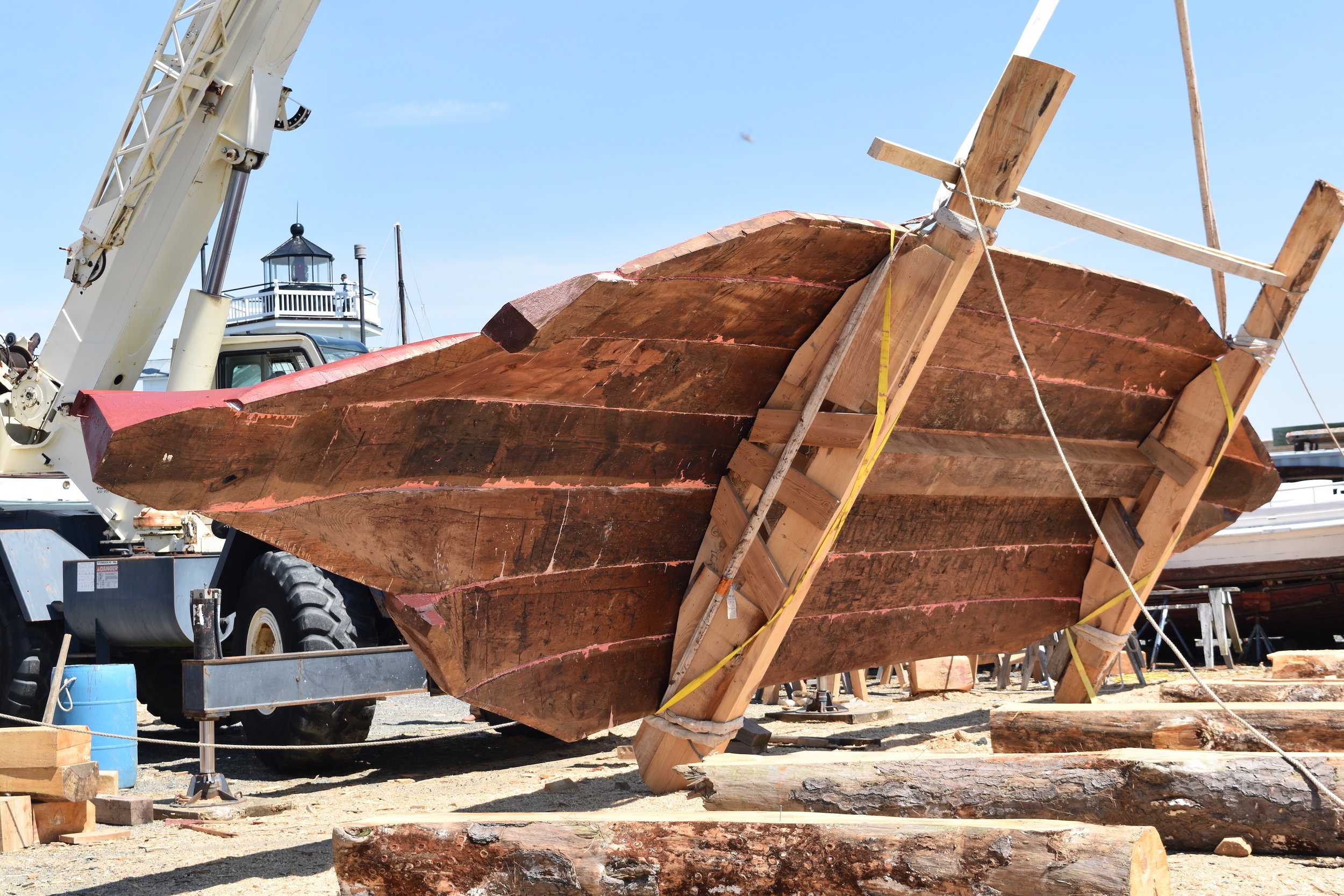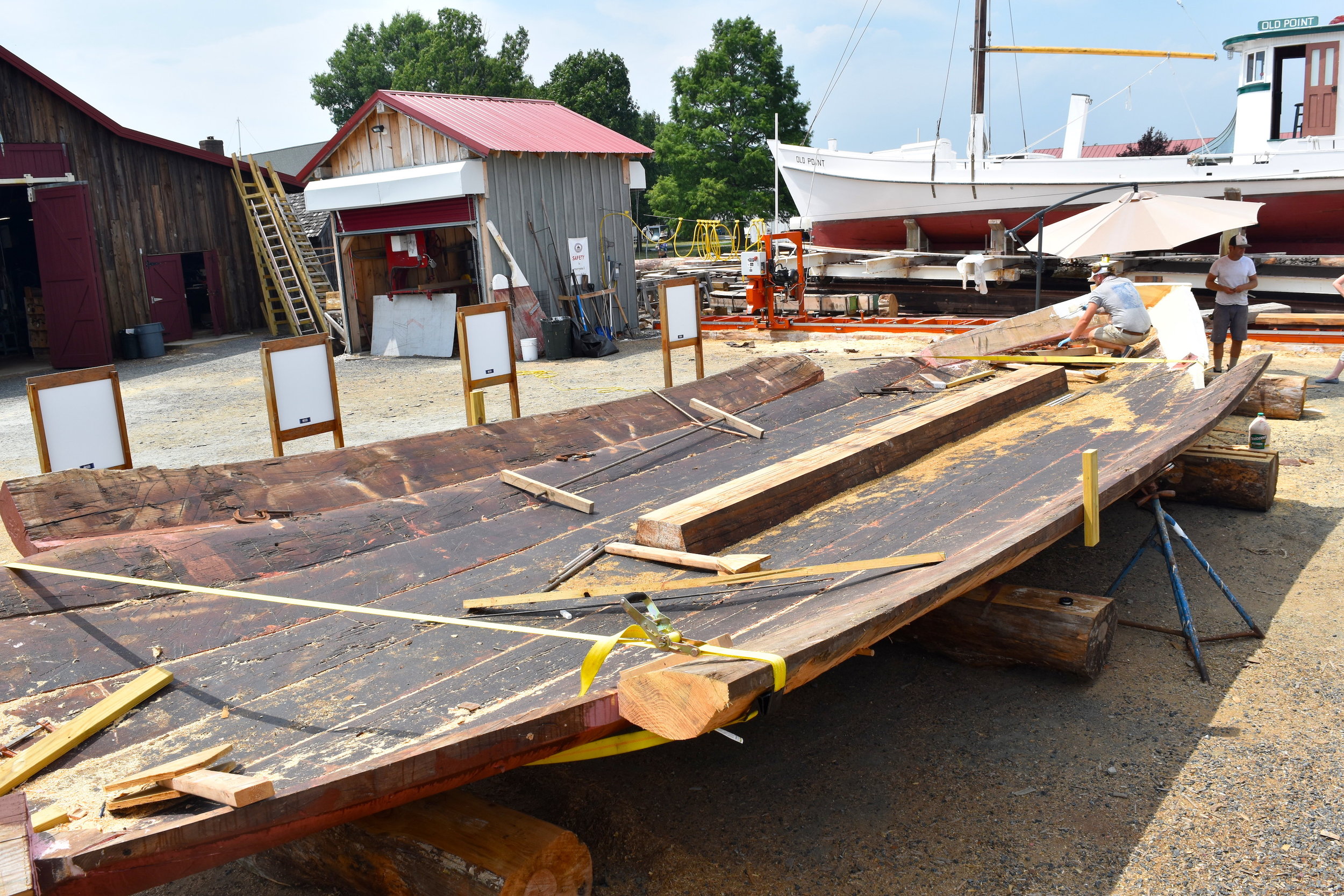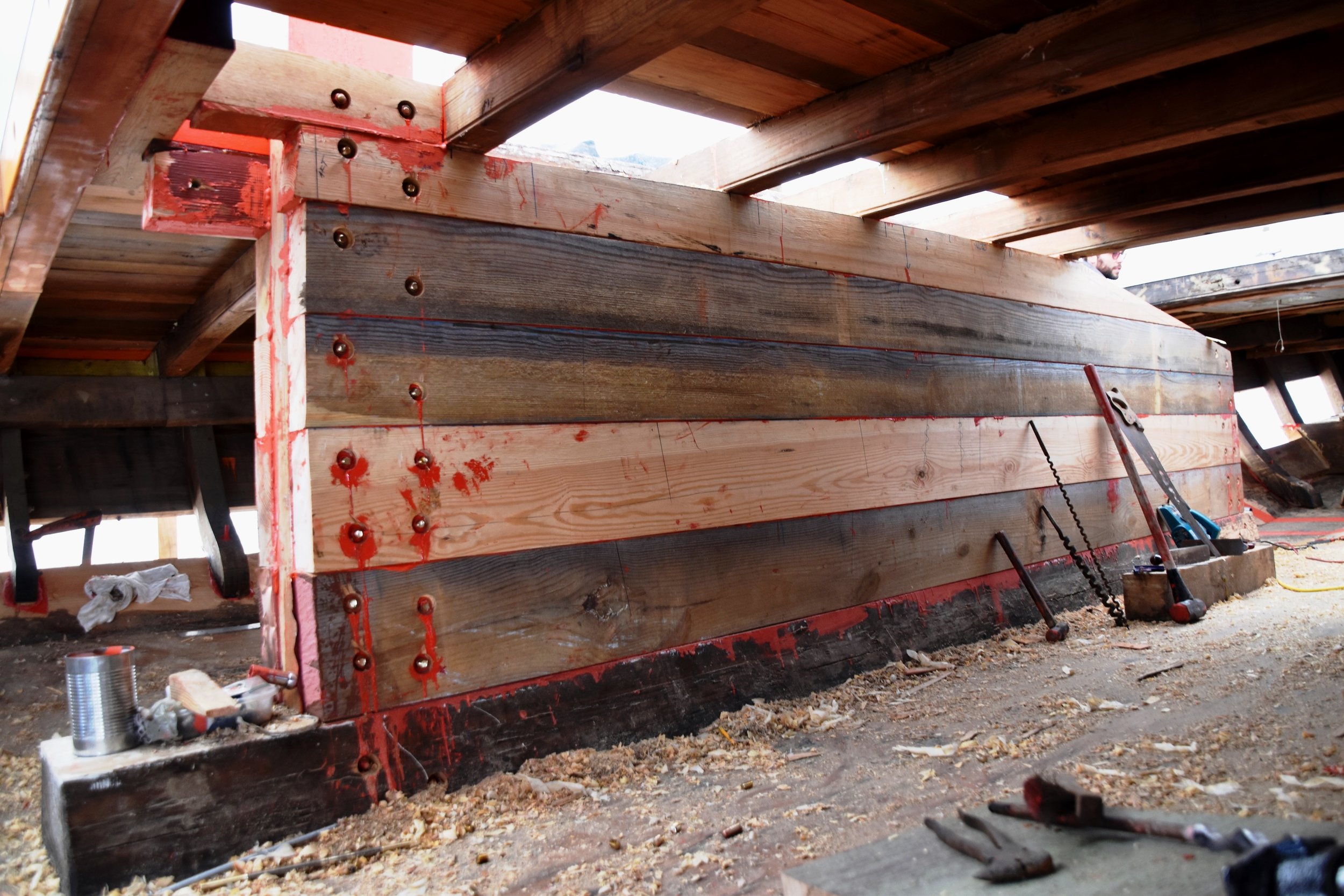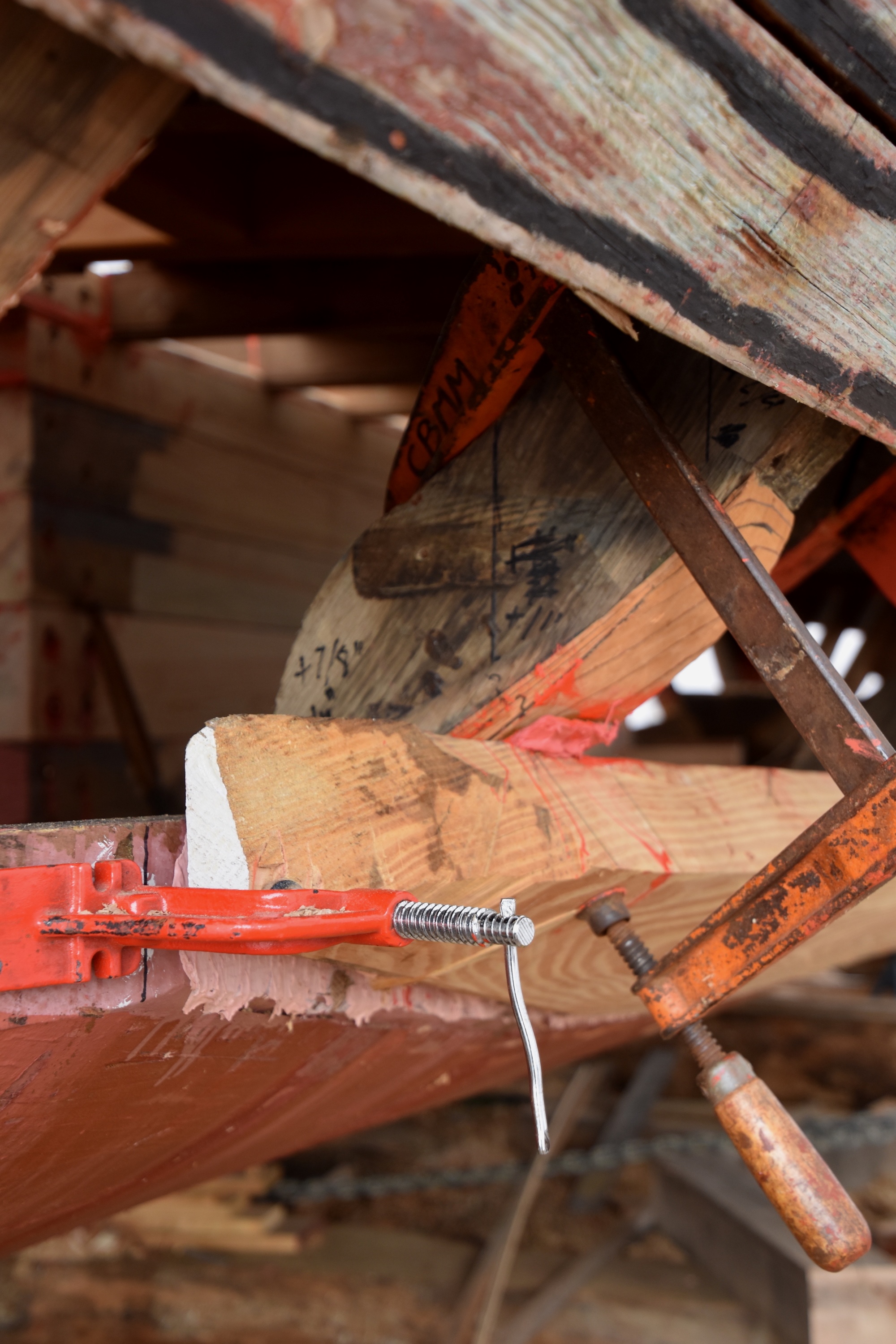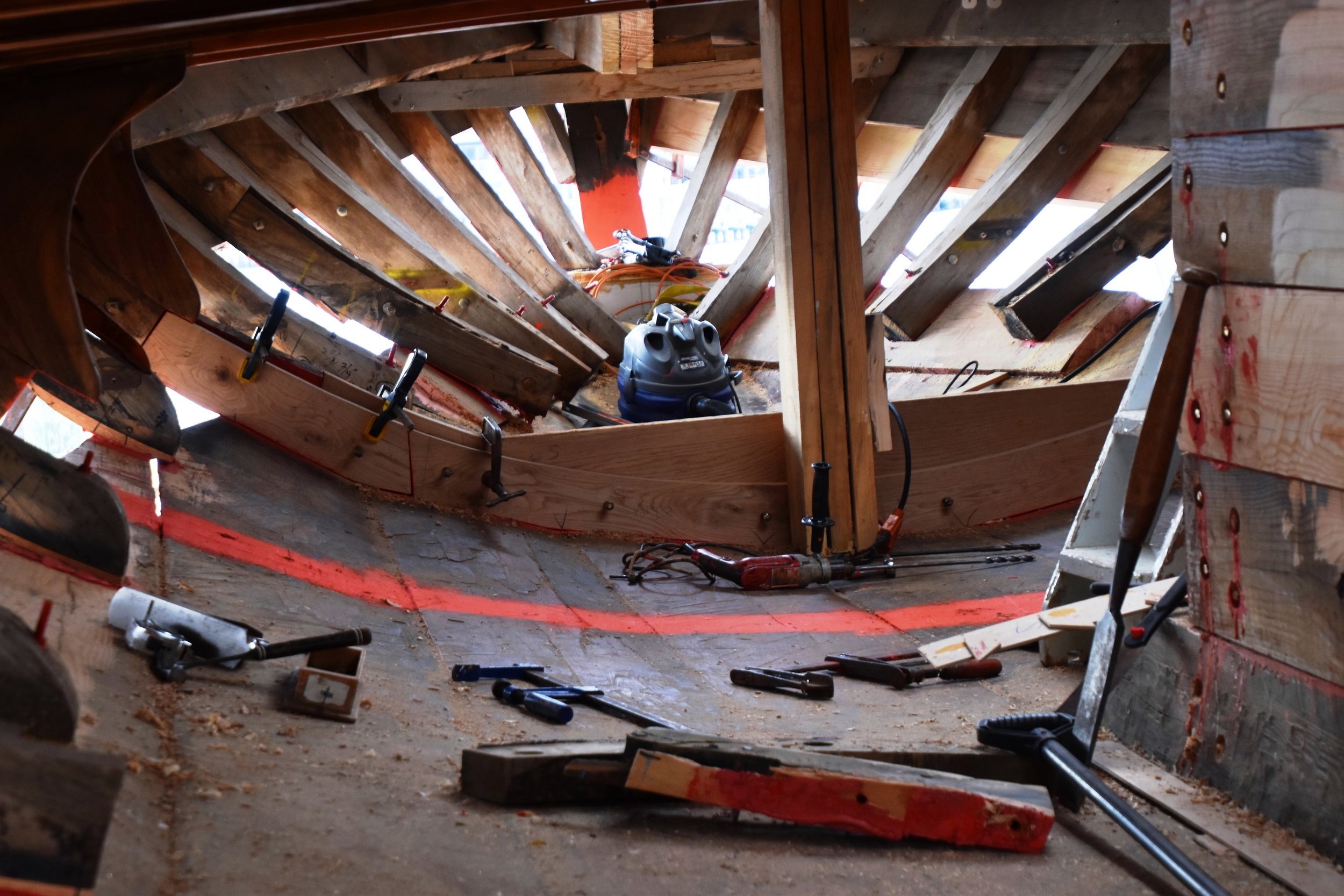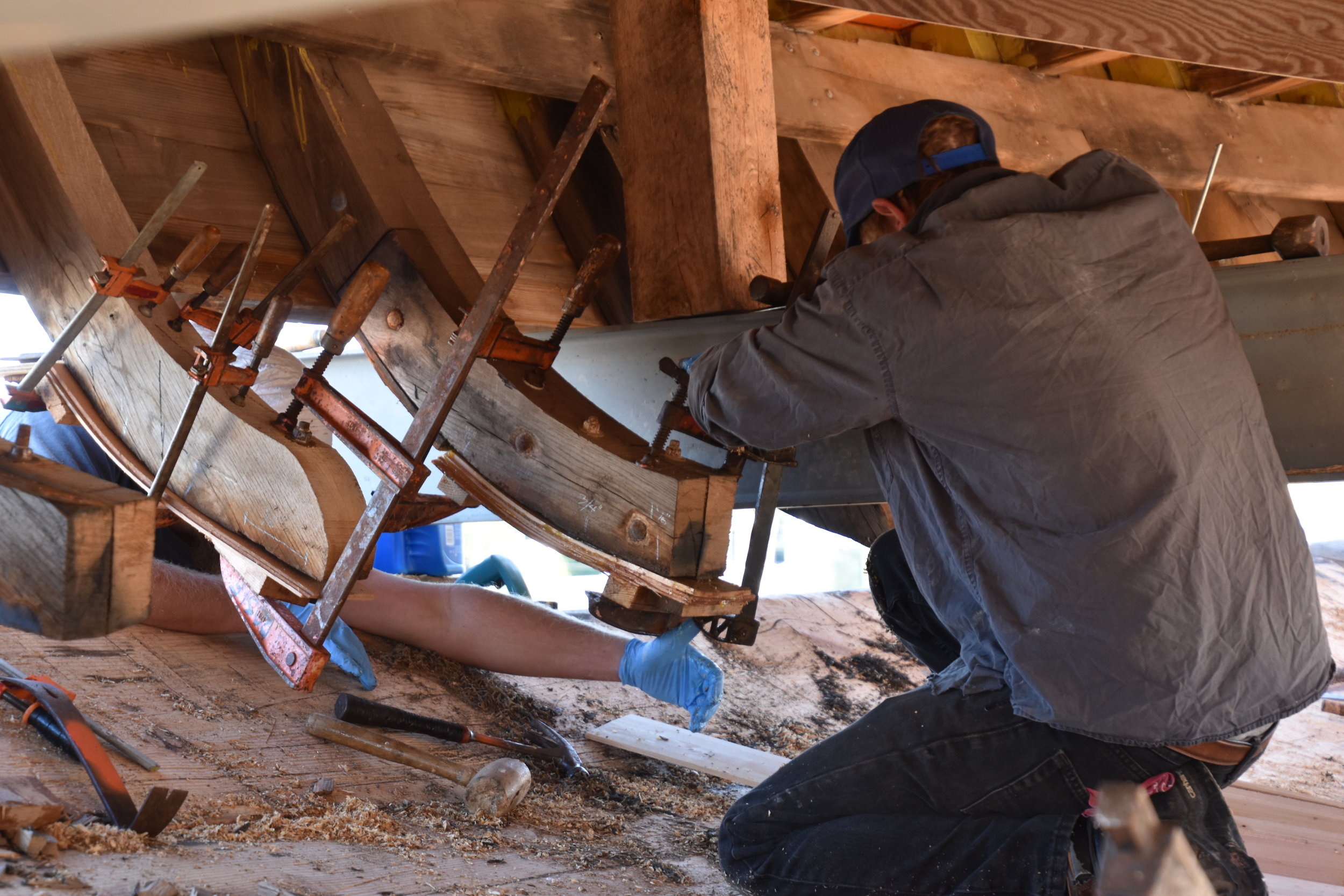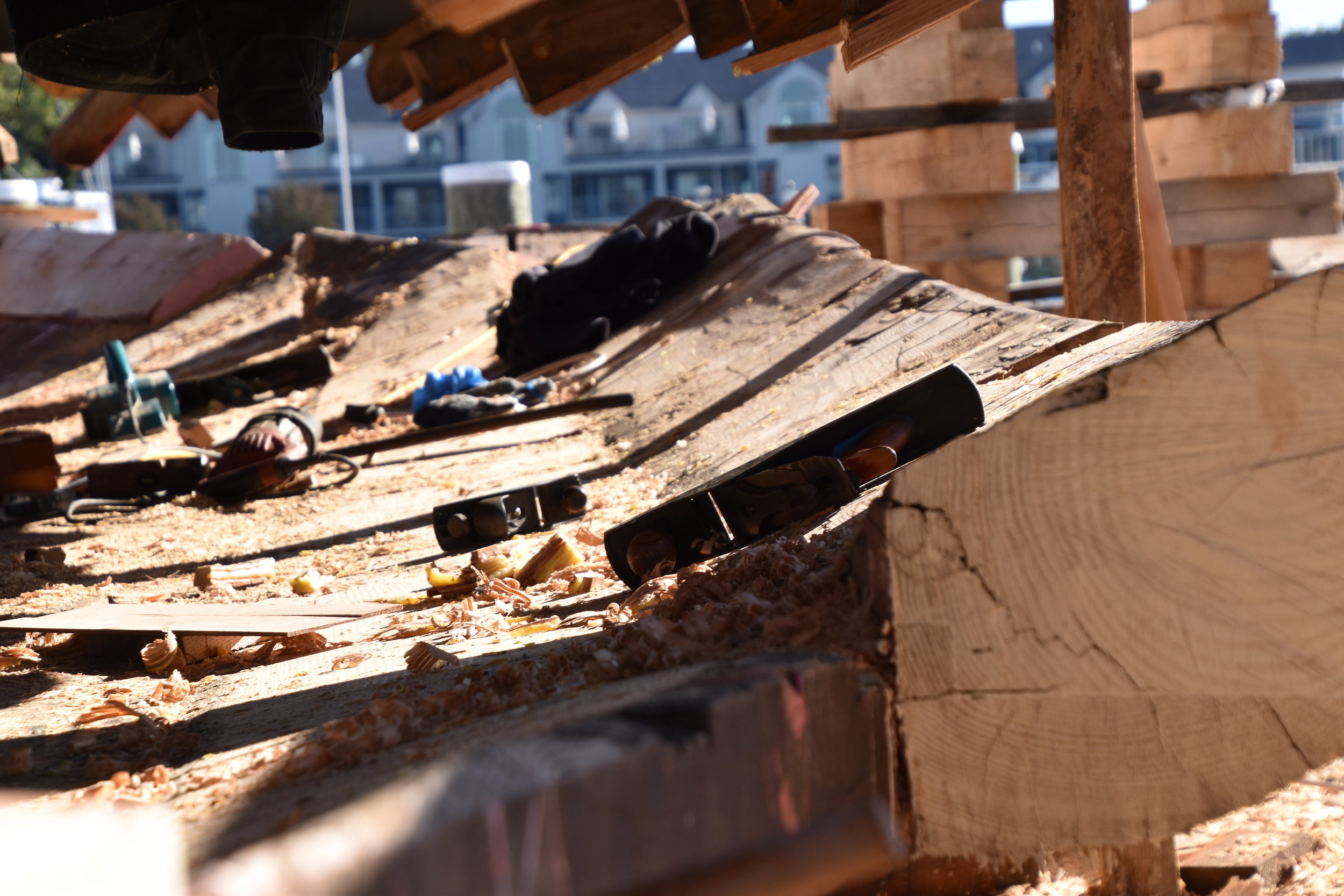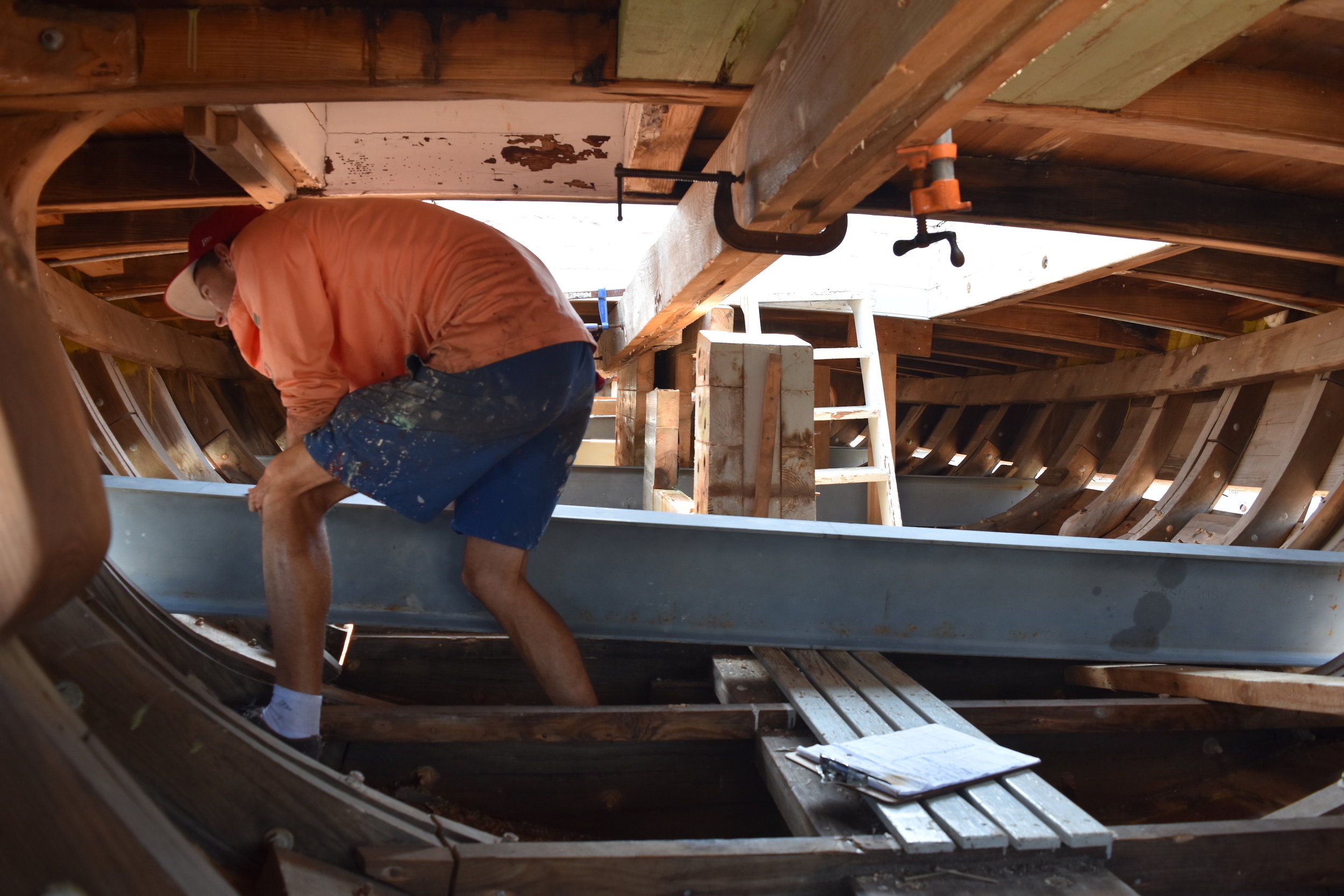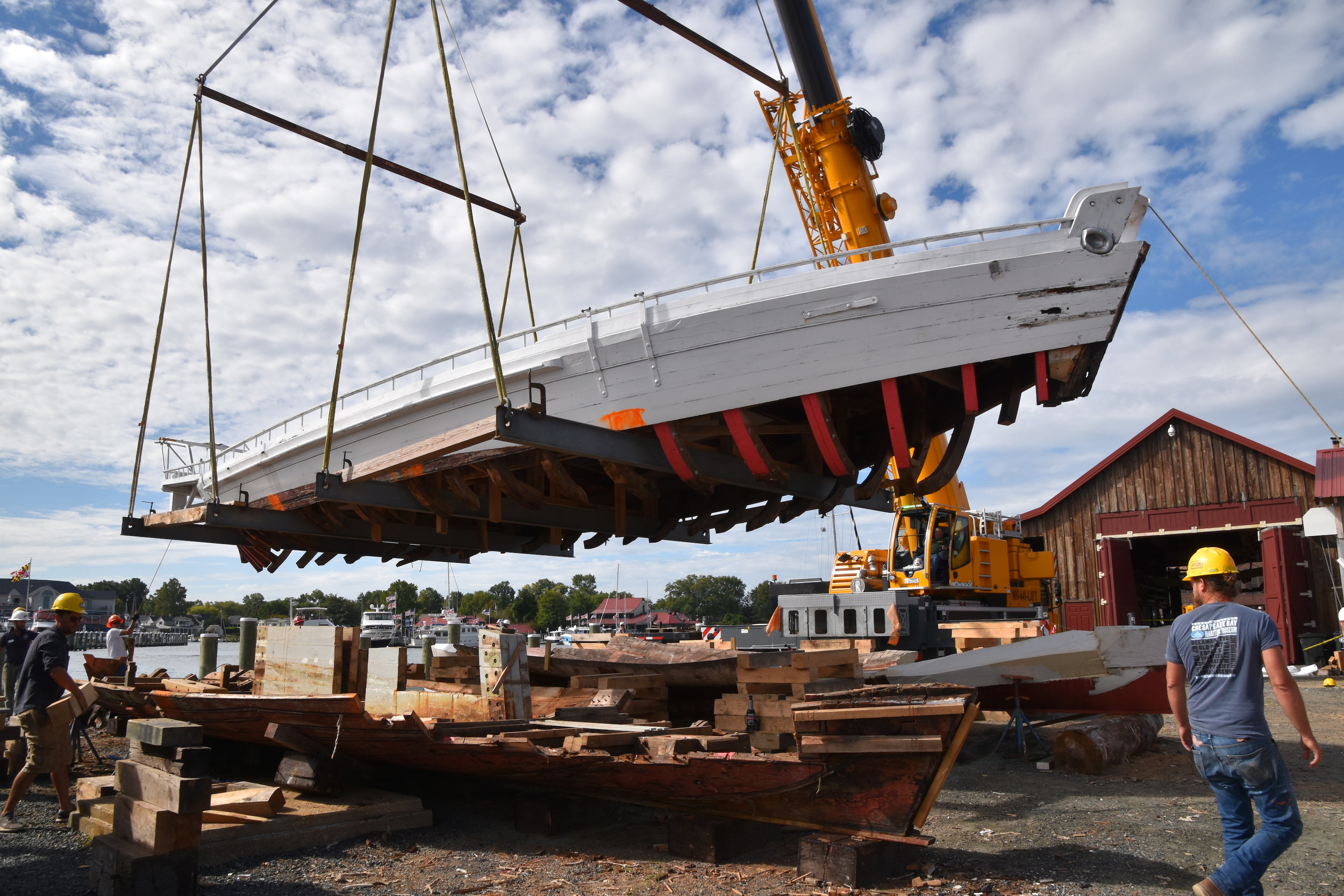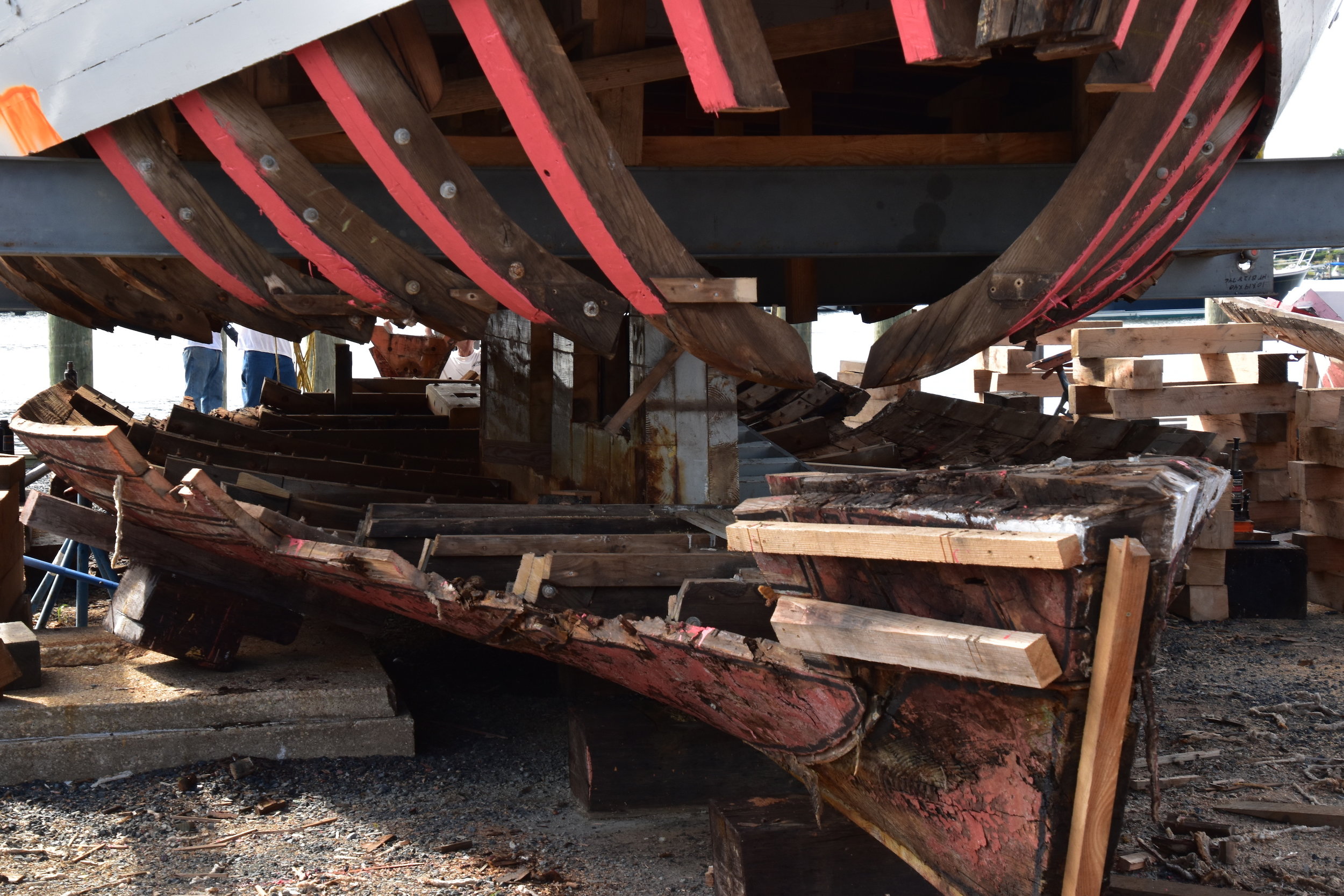Edna E. Lockwood sails for the first time after her two-year restoration at the Chesapeake Bay Maritime Museum. The 1889 bugeye was the last of her kind to harvest oysters on the Bay.
Bugeye Edna Lockwood relaunched at Chesapeake Bay Maritime Museum
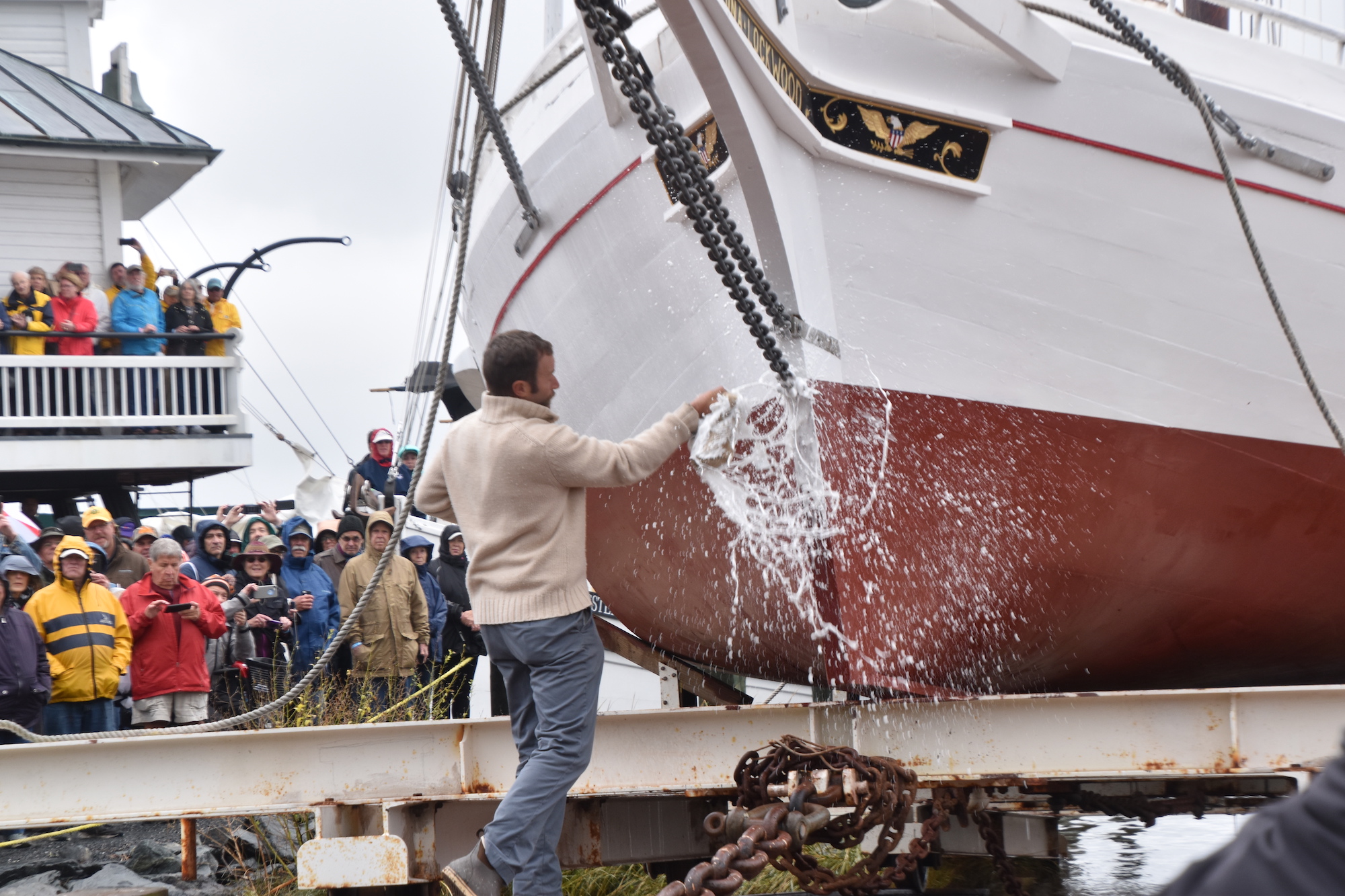
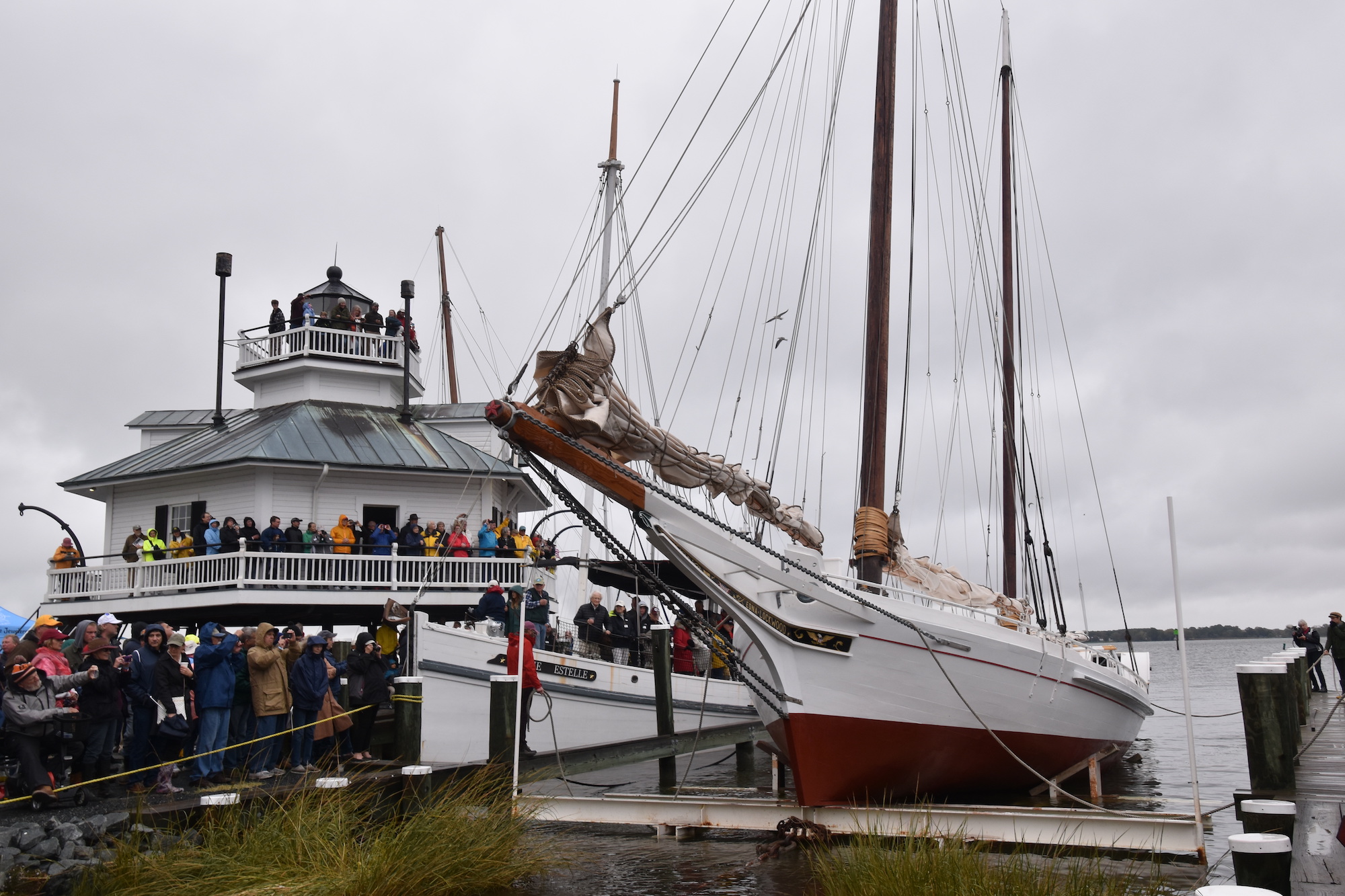
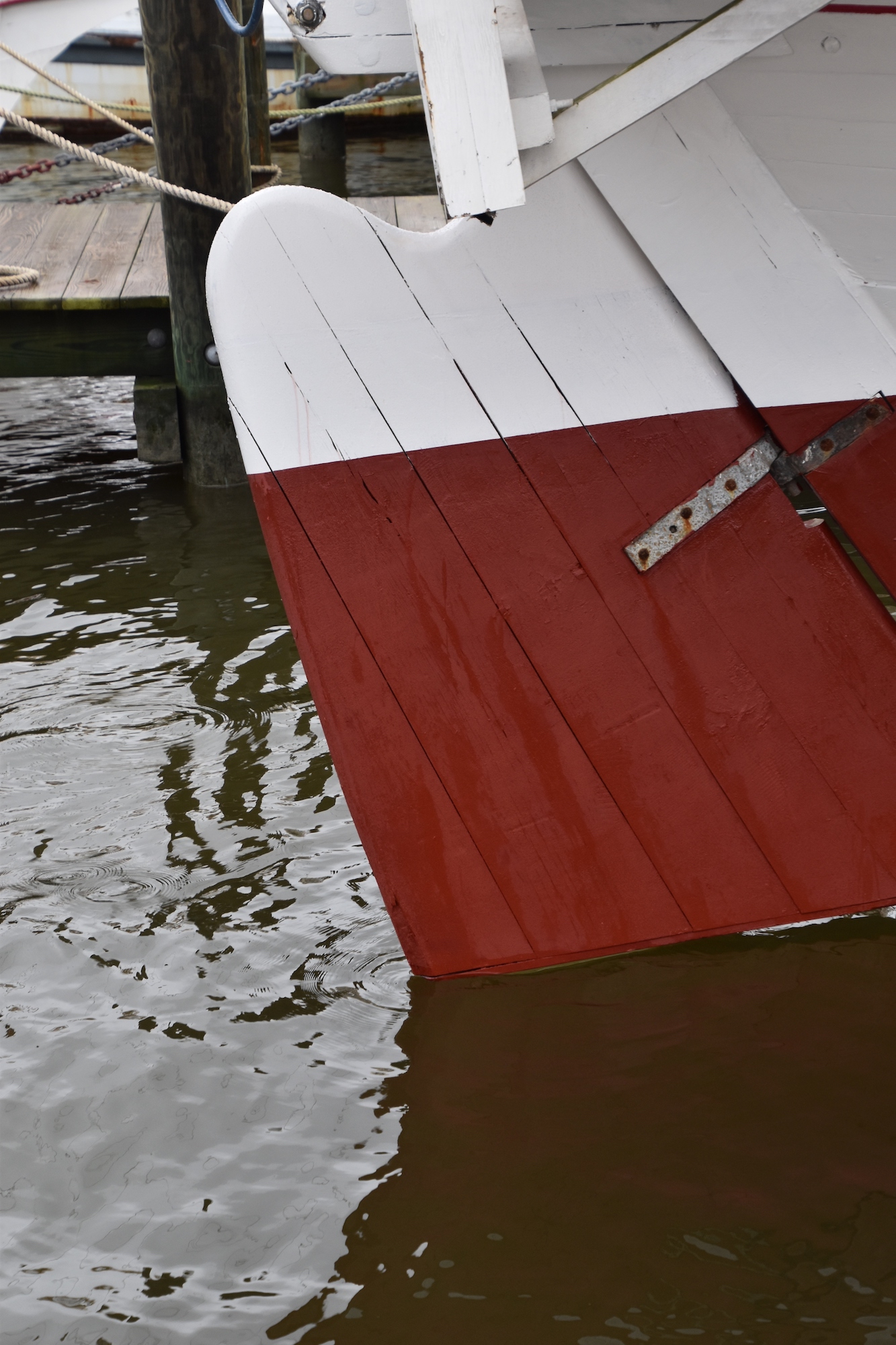
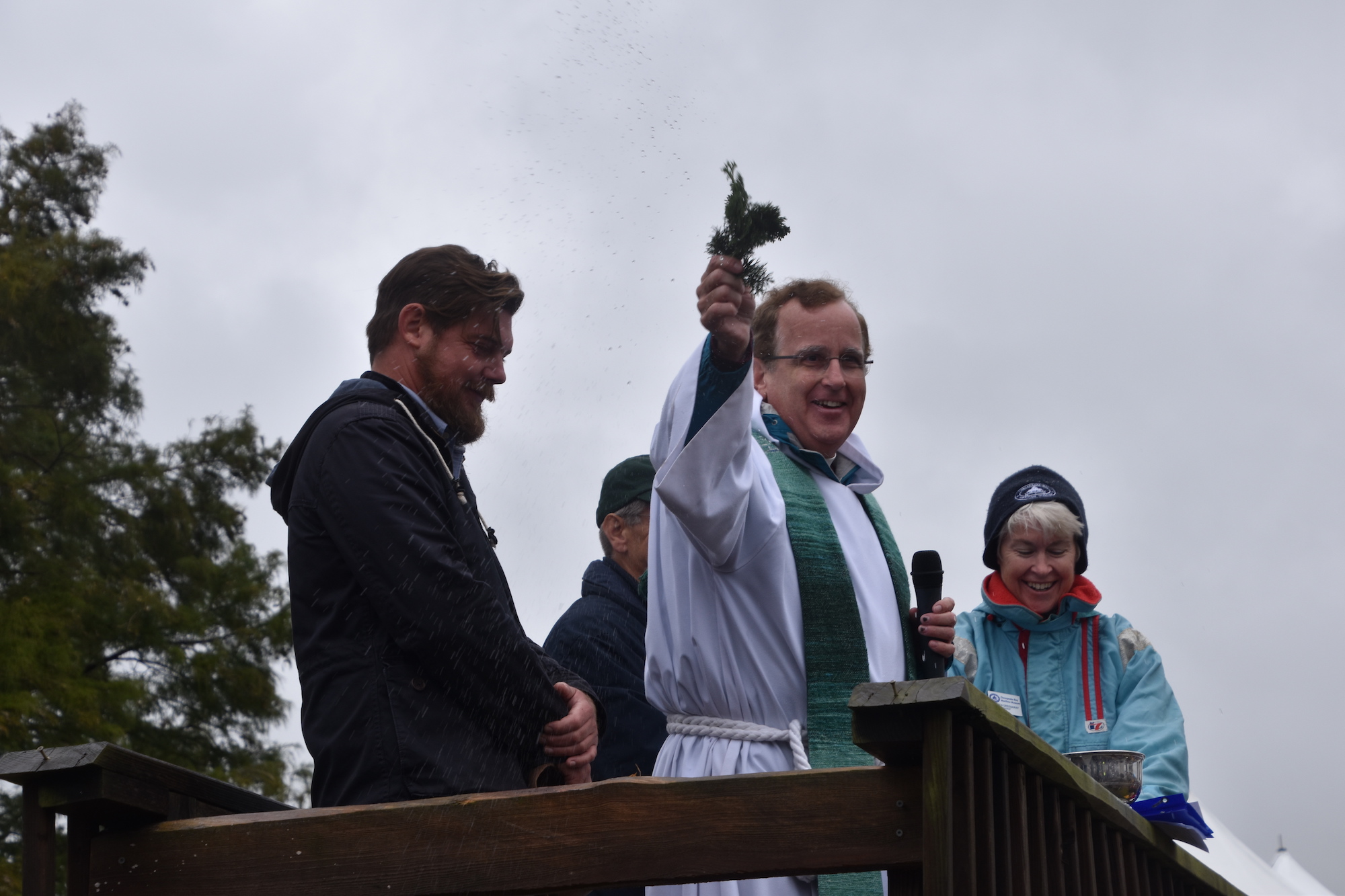
Following a historic two-year restoration project, 1889 bugeye Edna Lockwood was relaunched into the Miles River during the Chesapeake Bay Maritime Museum’s annual OysterFest on Saturday, Oct. 27, 2018.
Edna, queen of CBMM’s floating fleet, has spent the past several years having her nine-log hull completely replaced by CBMM shipwrights and apprentices. All work was done in full public view in St. Michaels, Md., and in adherence to the Secretary of the Interior’s Standards for Historic Vessel Preservation. Shipwright apprentices working on the project were generously supported by the Seip Family Foundation and the RPM Foundation.
Built in 1889 by John B. Harrison on Tilghman Island for Daniel W. Haddaway, Edna Lockwood dredged for oysters through winter, and carried freight—such as lumber, grain, and produce—after the dredging season ended. She worked faithfully for many owners, mainly out of Cambridge, Md., until she stopped “drudging” in 1967. In 1973, Edna was donated to the Chesapeake Bay Maritime Museum by John R. Kimberly. Recognized as the last working oyster boat of her kind, Edna Lockwood was declared a National Historic Landmark in 1994. Edna is the last historic sailing bugeye in the world, and will undertake a heritage tour around the Chesapeake Bay during summer 2019, funded by the National Park Service.
To learn more about Edna Lockwood and what’s next for the Chesapeake Bay Maritime Museum’s Shipyard, visit cbmmshipyard.org.
Edna E. Lockwood Relaunch!
A highlight of this year's OysterFest at the Chesapeake Bay Maritime Museum on Oct. 27 was the re-launch of the 1889 bugeye Edna E. Lockwood. Her nine-log hull was restored by CBMM shipwrights and apprentices over the past two years. Edna Lockwood, the last boat of her kind to harvest oysters, is the queen of CBMM’s floating fleet of historic boats and a National Historic Landmark. She returns to the Chesapeake Bay for her new job as a floating classroom.
Edna E. Lockwood: Bottoms Up by Sandy Cannon-Brown
After a remarkable restoration, Edna E. Lockwood, the last bugeye to harvest oysters on the Chesapeake Bay will return to work, this time as a floating classroom. Edna will relaunch during OysterFest 2018 at the Chesapeake Bay Maritime Museum.
Edna Lockwood restoration to finish this fall
Chesapeake Bay Maritime Museum Shipyard Manager Michael Gorman reports restoration work on the nine-log hull of the 1889 bugeye Edna Lockwood is coming to an end. Two years of work on the National Historic Landmark will come to an end with her relaunch at CBMM’s OysterFest in St. Michaels on Oct. 27, 2018.
With the completion of planking and fairing this fall, the shipyard crew then finished caulking all seams, knifed in seam compound, and gave the bugeye a couple of coats of paint. Her decorative red bead has been painted and trailboards have been installed. Edna has now been floating for a few weeks and swelling up nicely.
CBMM’s shipwright apprentices have been busy finishing pieces of the restoration ahead of her relaunch. Shipwright Apprentice Michael Allen is working on some windows, while Seip Family Foundation Shipwright Apprentice Spencer Sherwood installed her trailboards and built out the trim that goes around them. Seip Family Foundation Shipwright Apprentice Zach Haroth headed up paint and lead flashing details that protect various bits topsides, while also putting in final bolts in the deck structure, and Apprentice Sam Hilgartner built the new standing rigging for Edna in CBMM’s Corn Crib. This marks the first time CBMM has built its own rigging, providing a much-needed upgrade to Edna and her ability to undertake a National Park Service-funded Heritage Tour next summer.
The final steps in the project will include pulling out Edna’s masts, putting on the new rigging, and stepping them. After this, her push boat and centerboard will be installed, and booms and sails created by Traditional Rigging Co. in Maine, will be added.
Edna Lockwood's sails finished
Shipwrights and apprentices from the Chesapeake Bay Maritime Museum recently traveled to Appleton, Maine, to pick up new sails for Edna Lockwood. The sails were created by Traditional Rigging Co., and will go on Edna ahead of her October re-launch.
Flip through the photos below to see some of the sail-making process. Photos courtesy of Traditional Rigging Co.
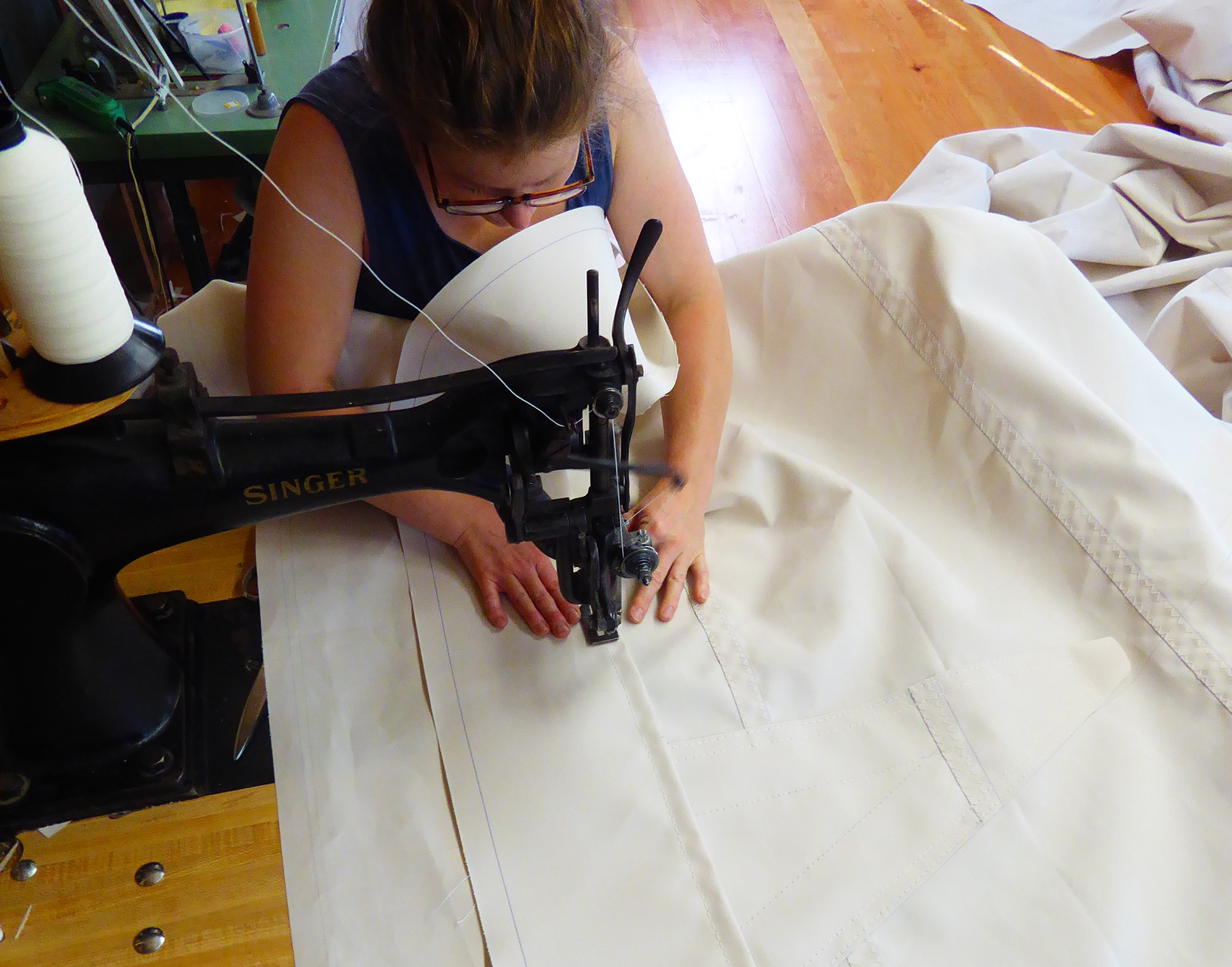
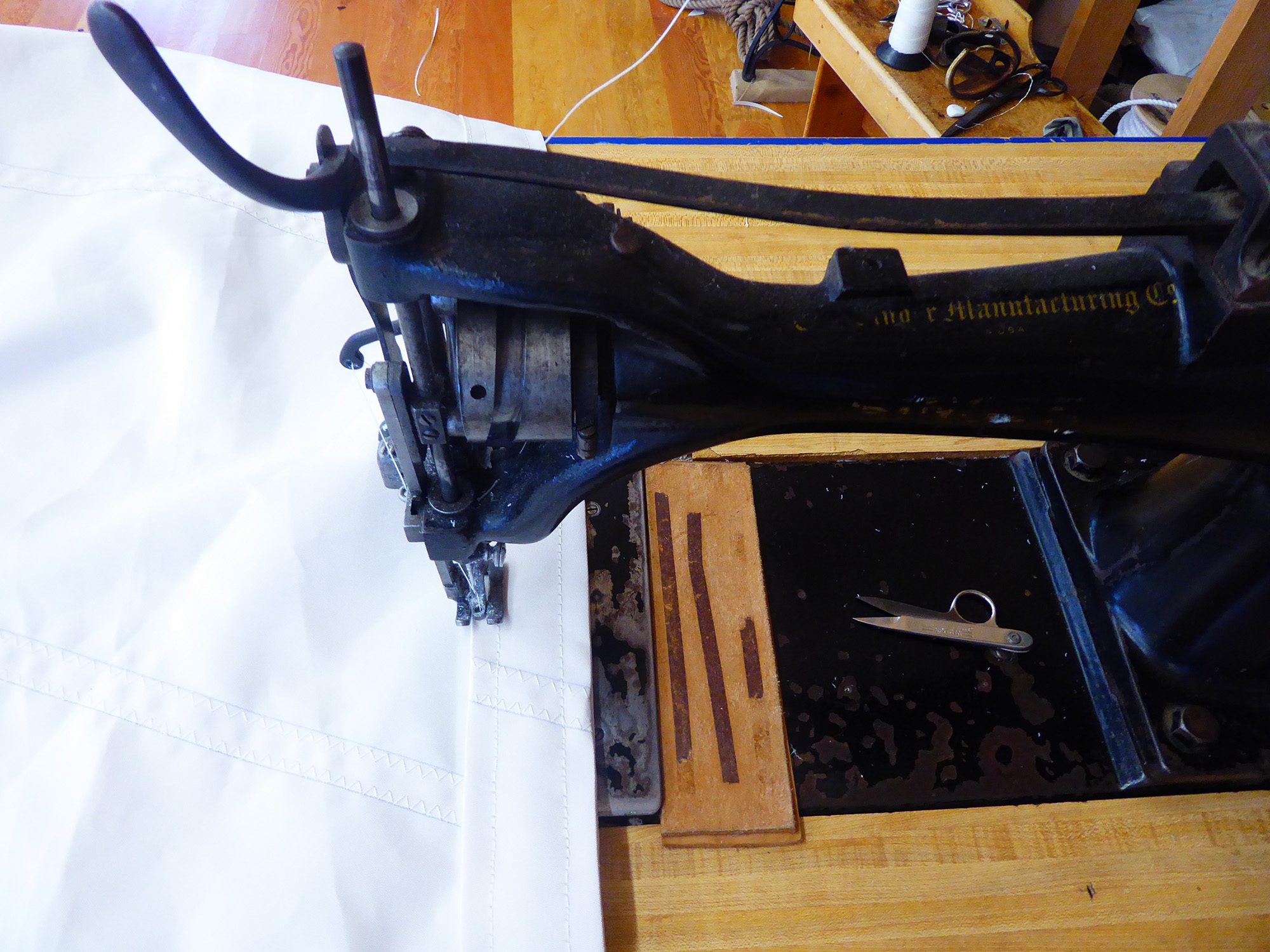
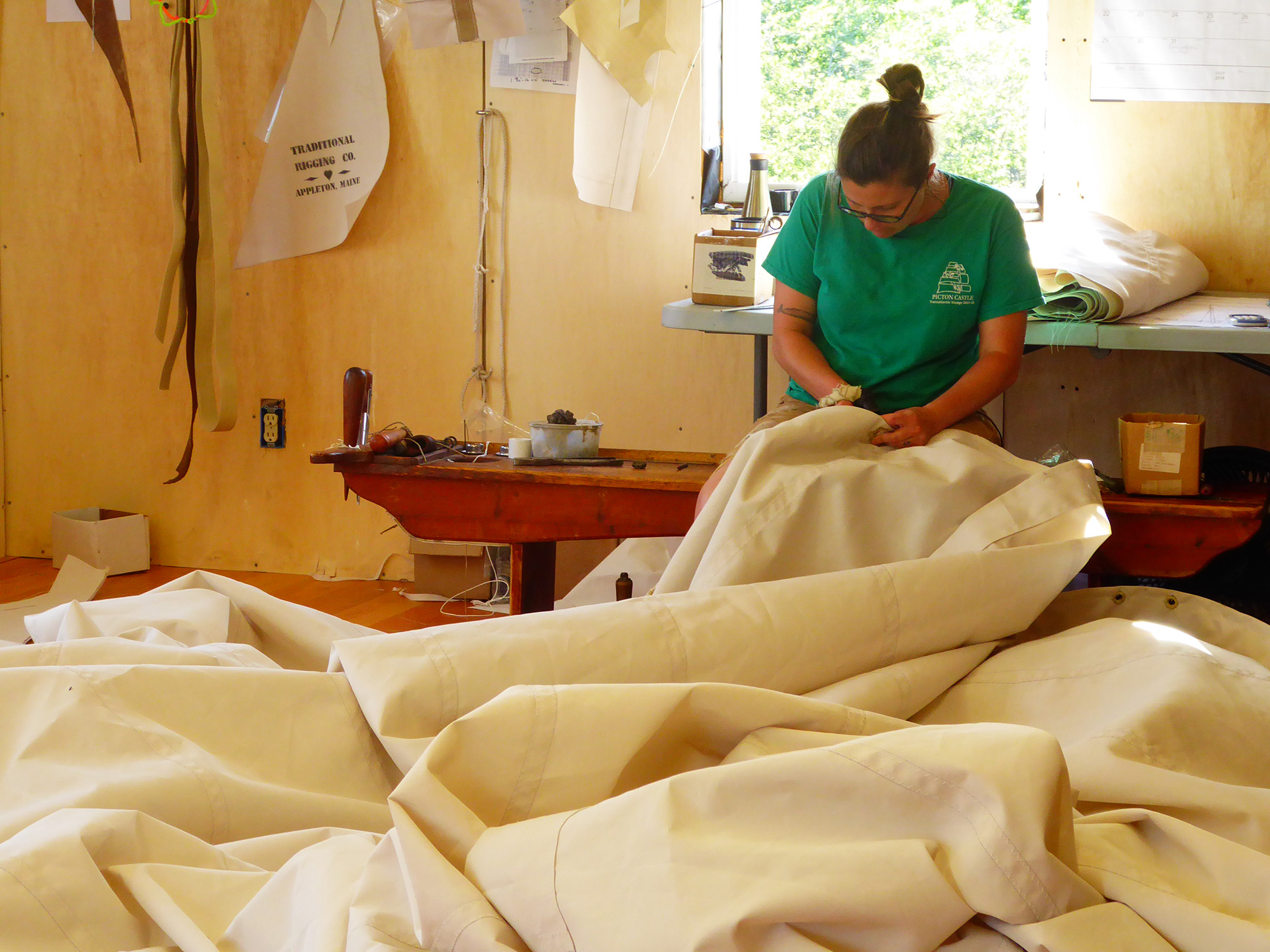
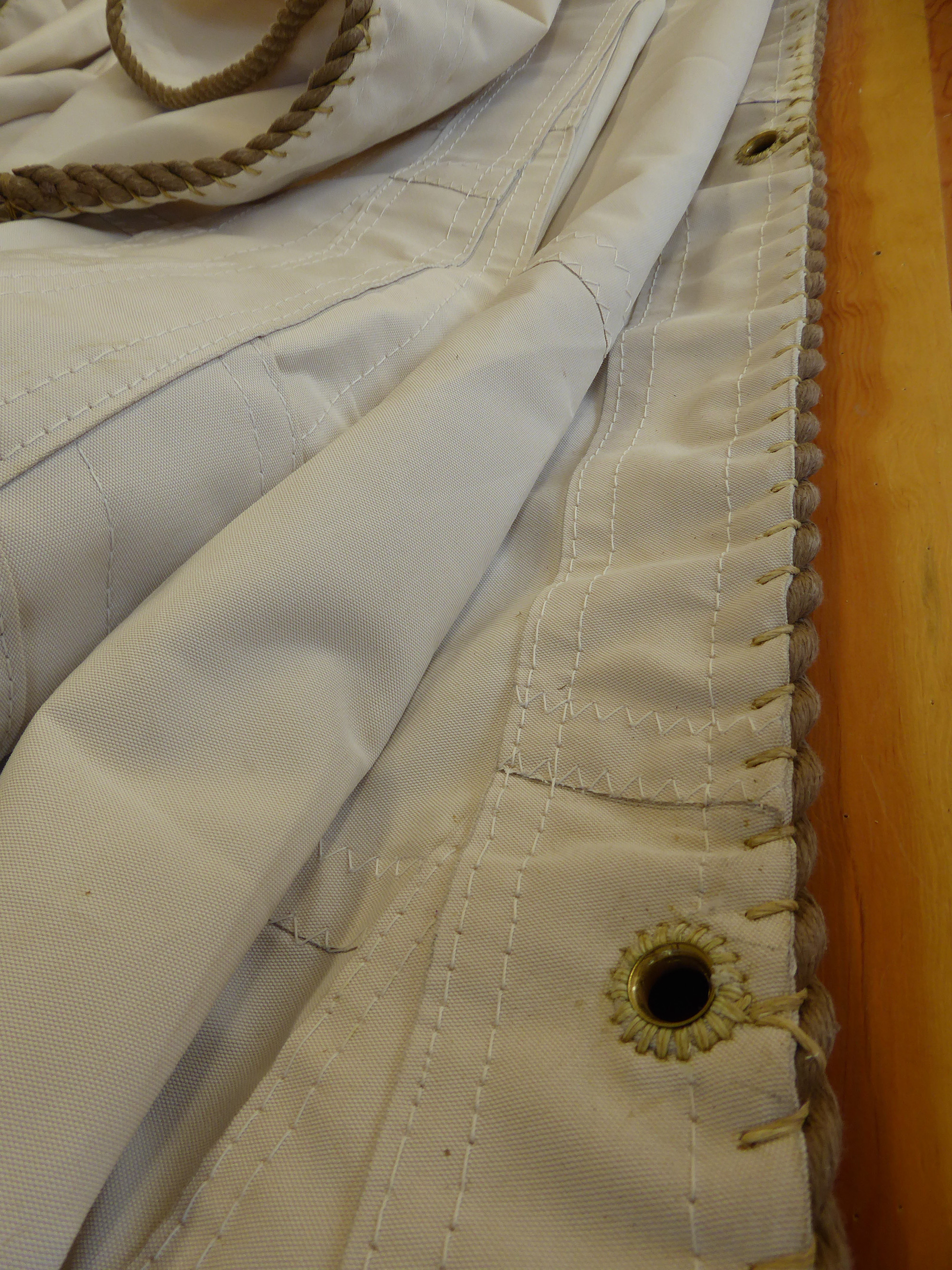
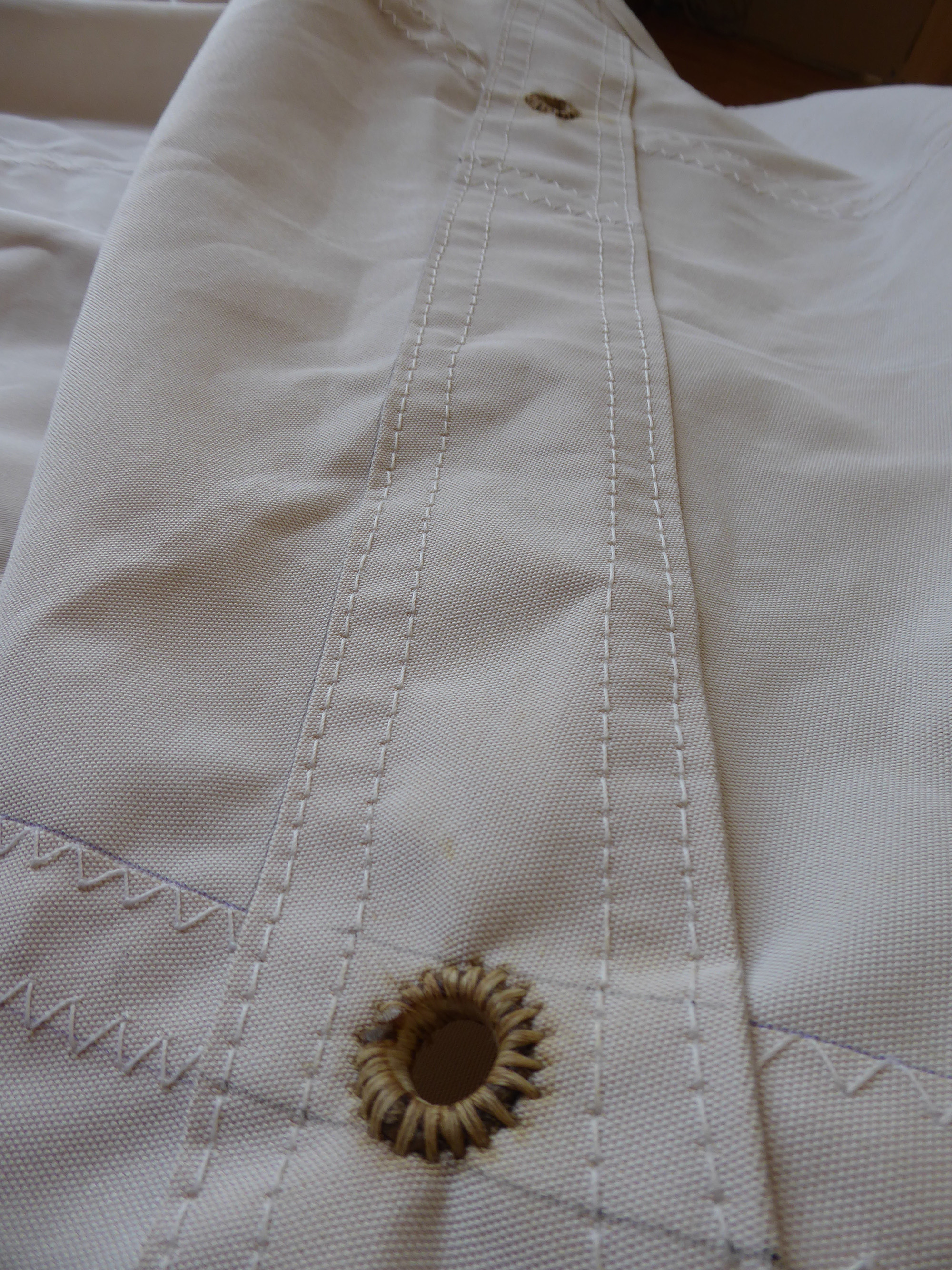
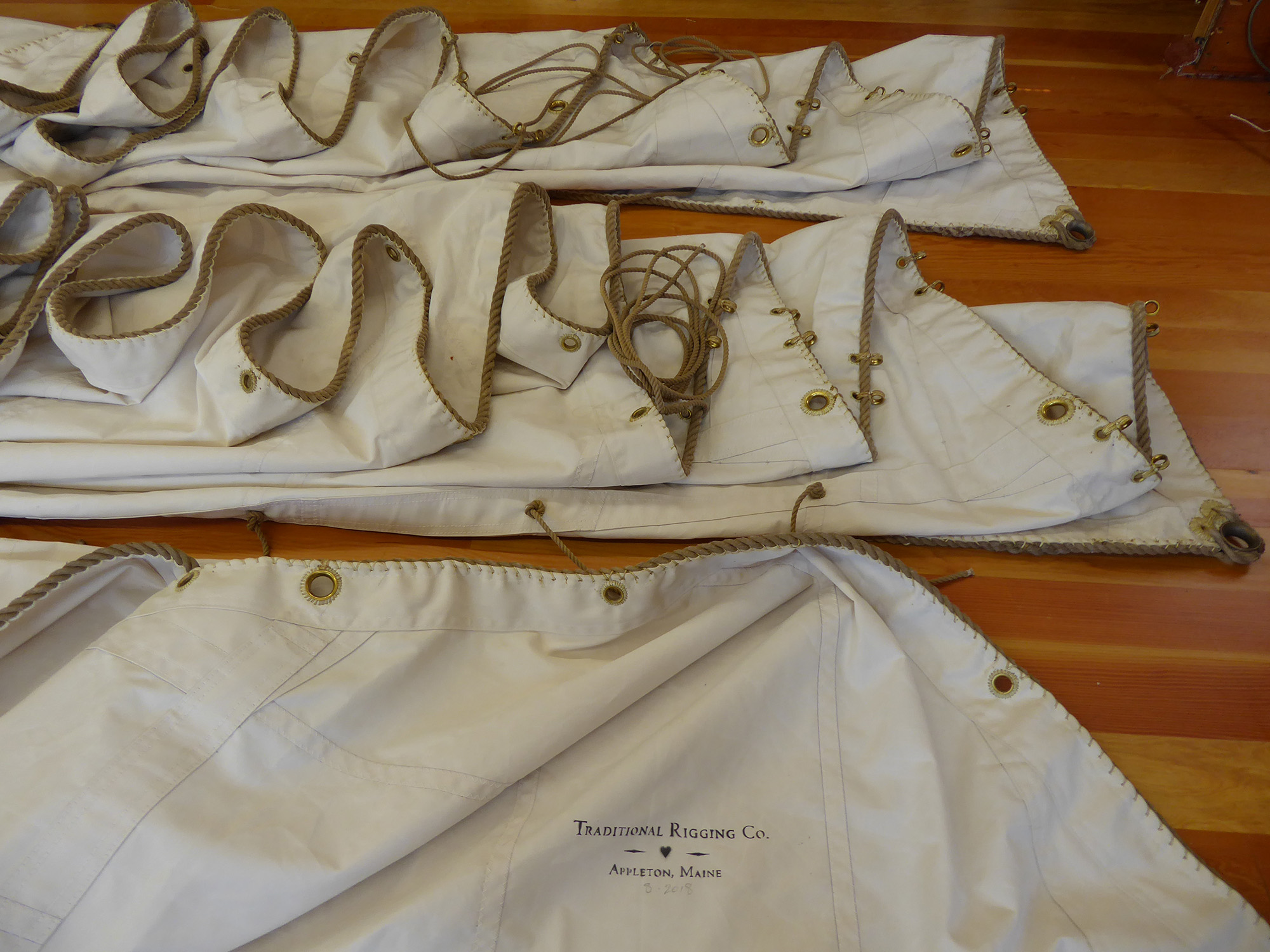

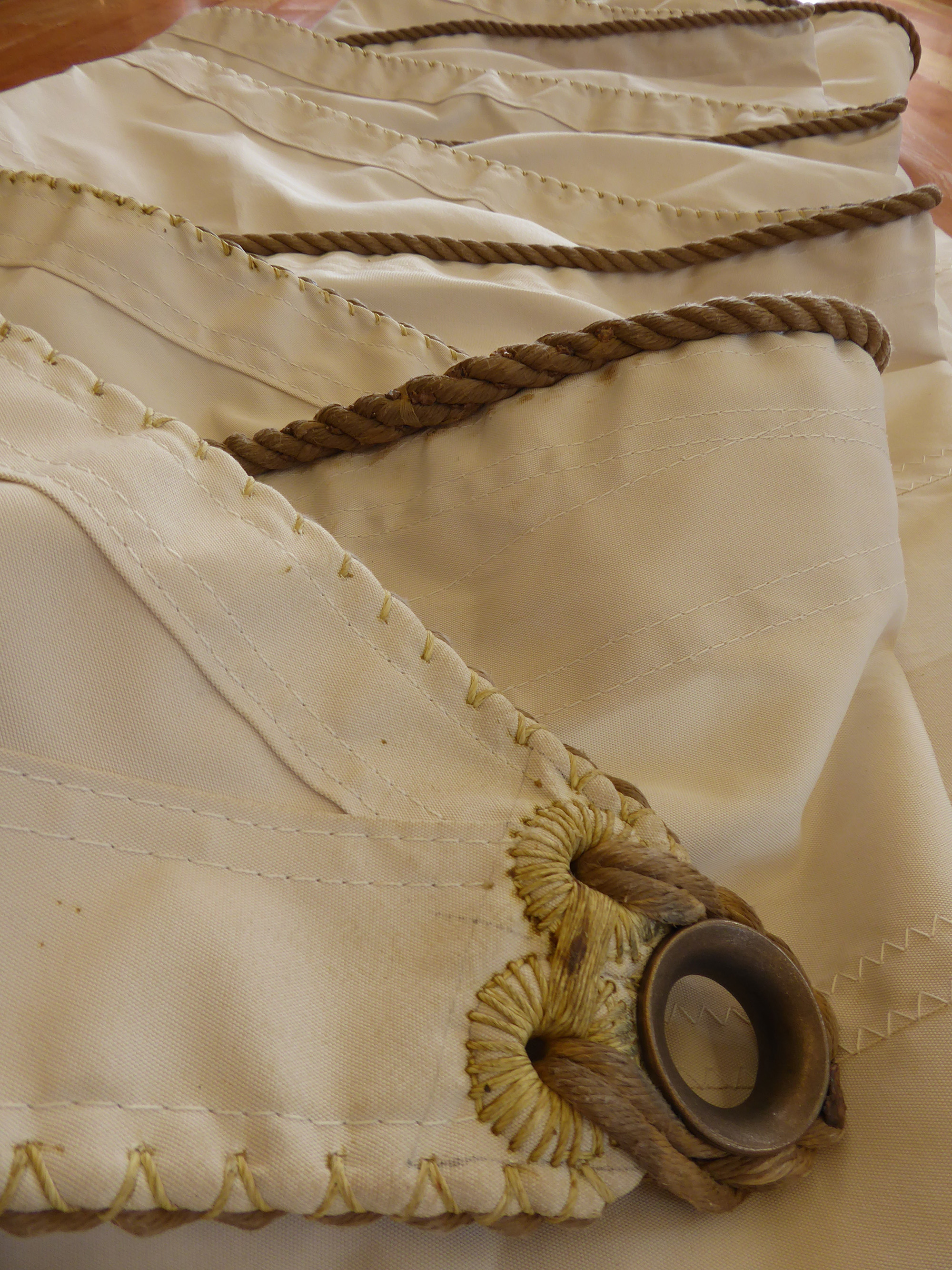
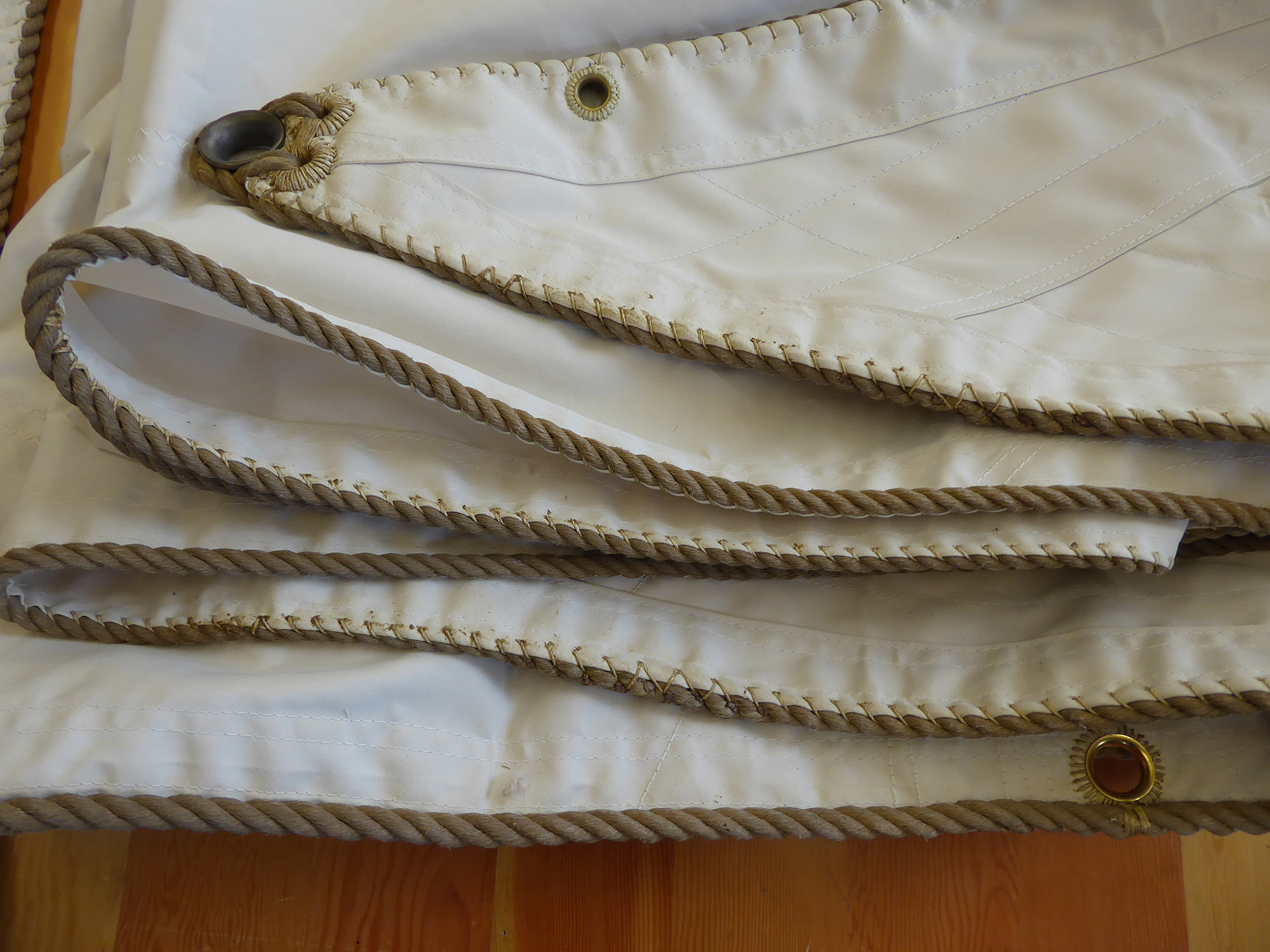
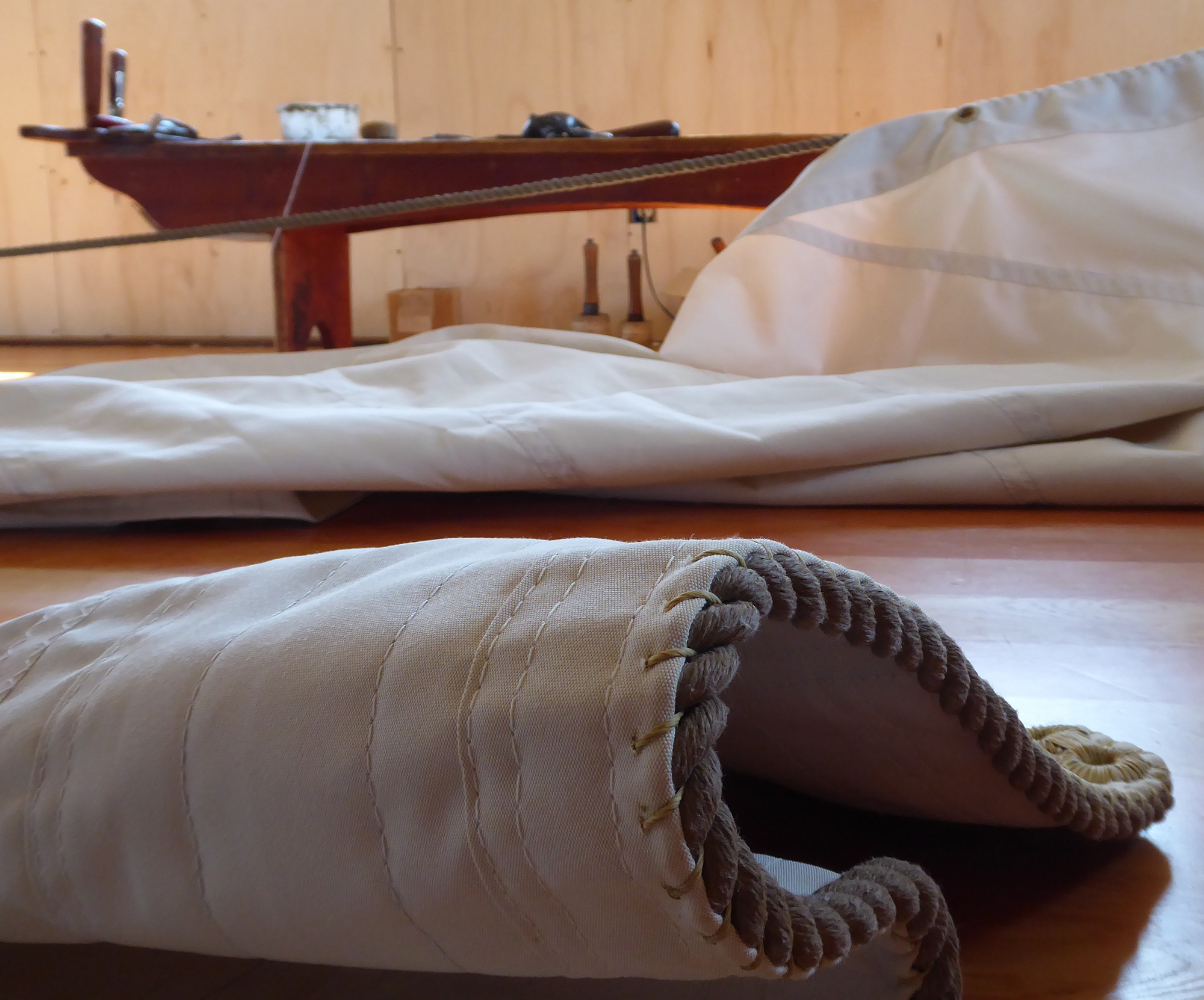
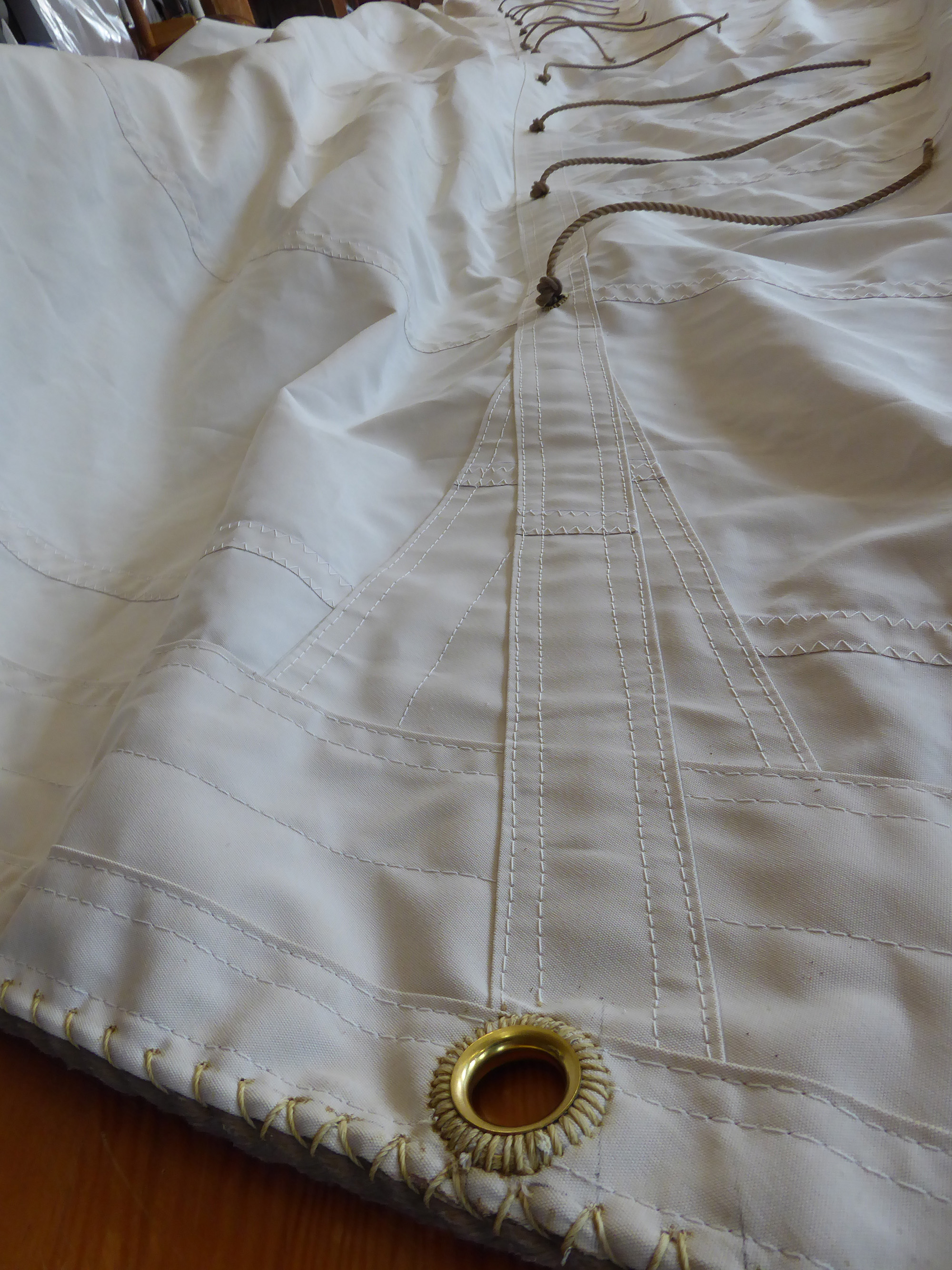
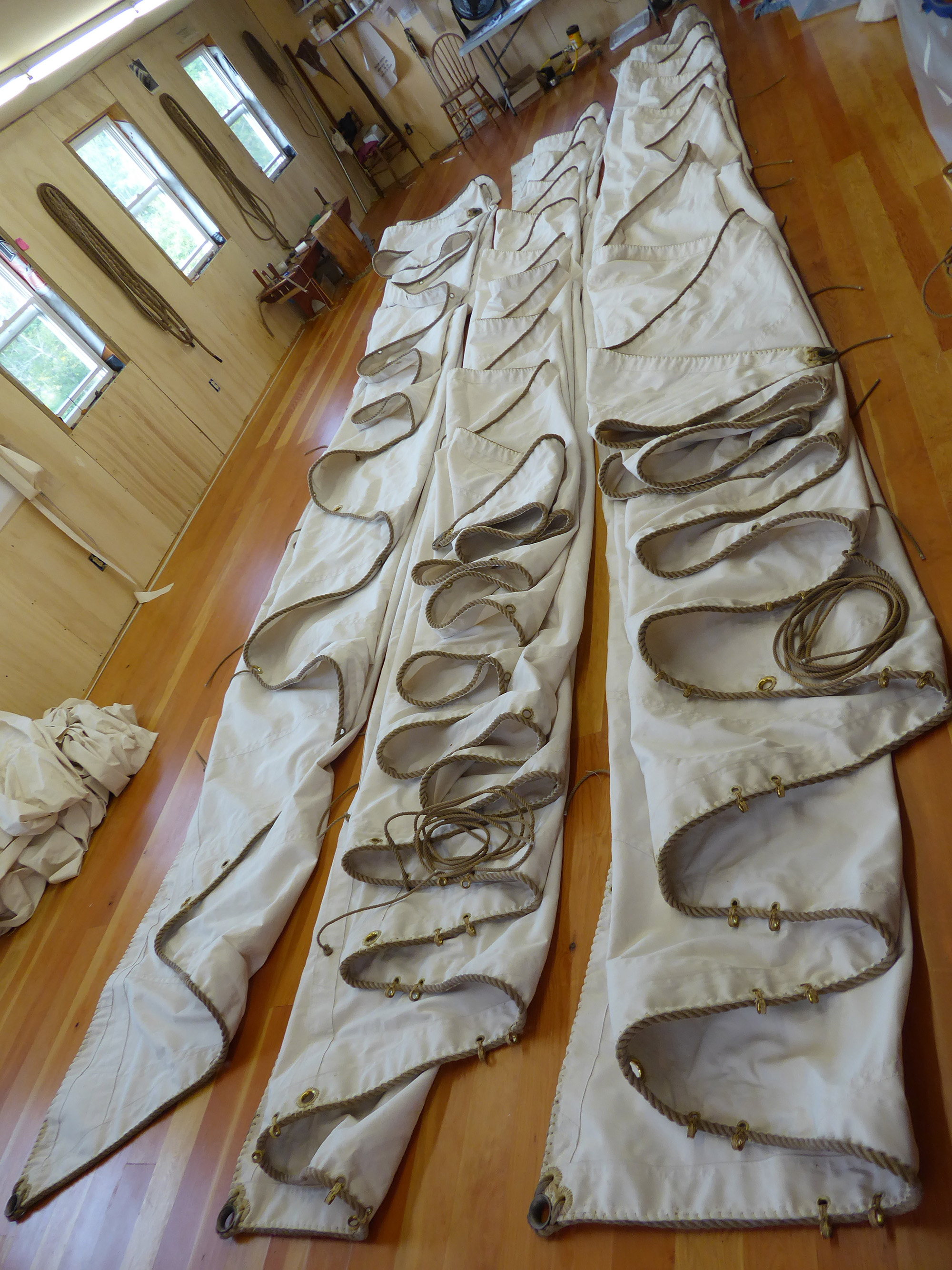
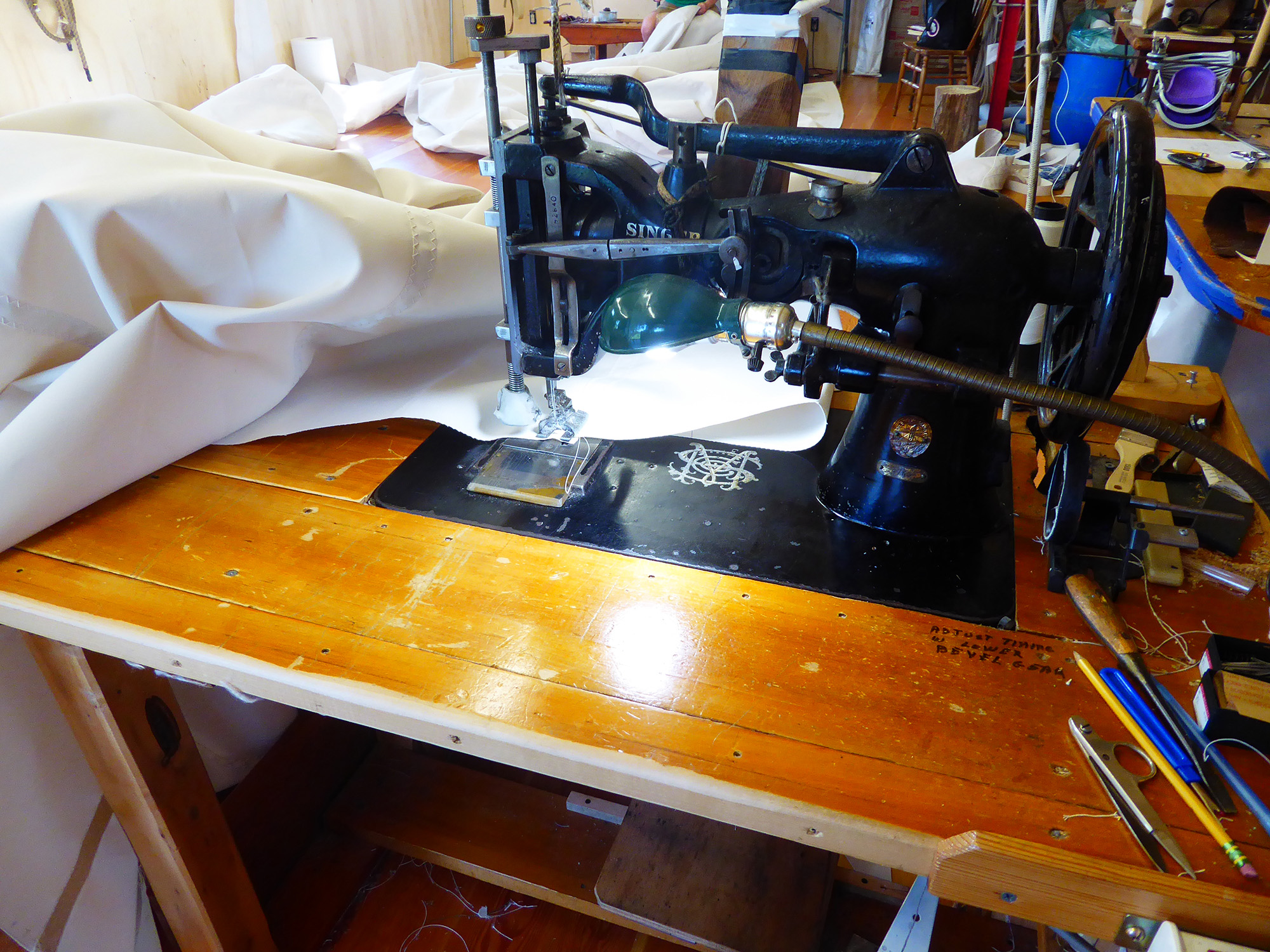

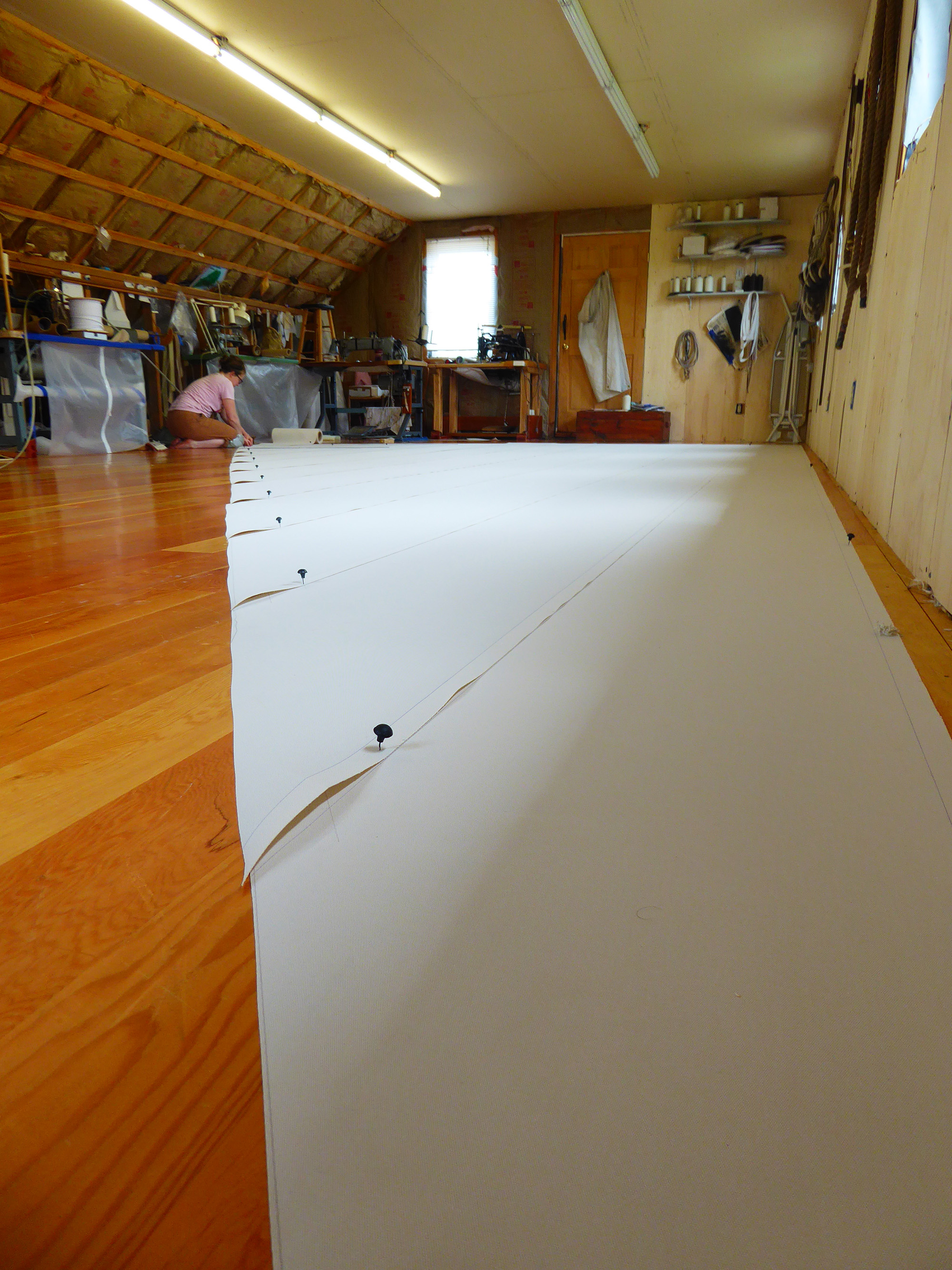
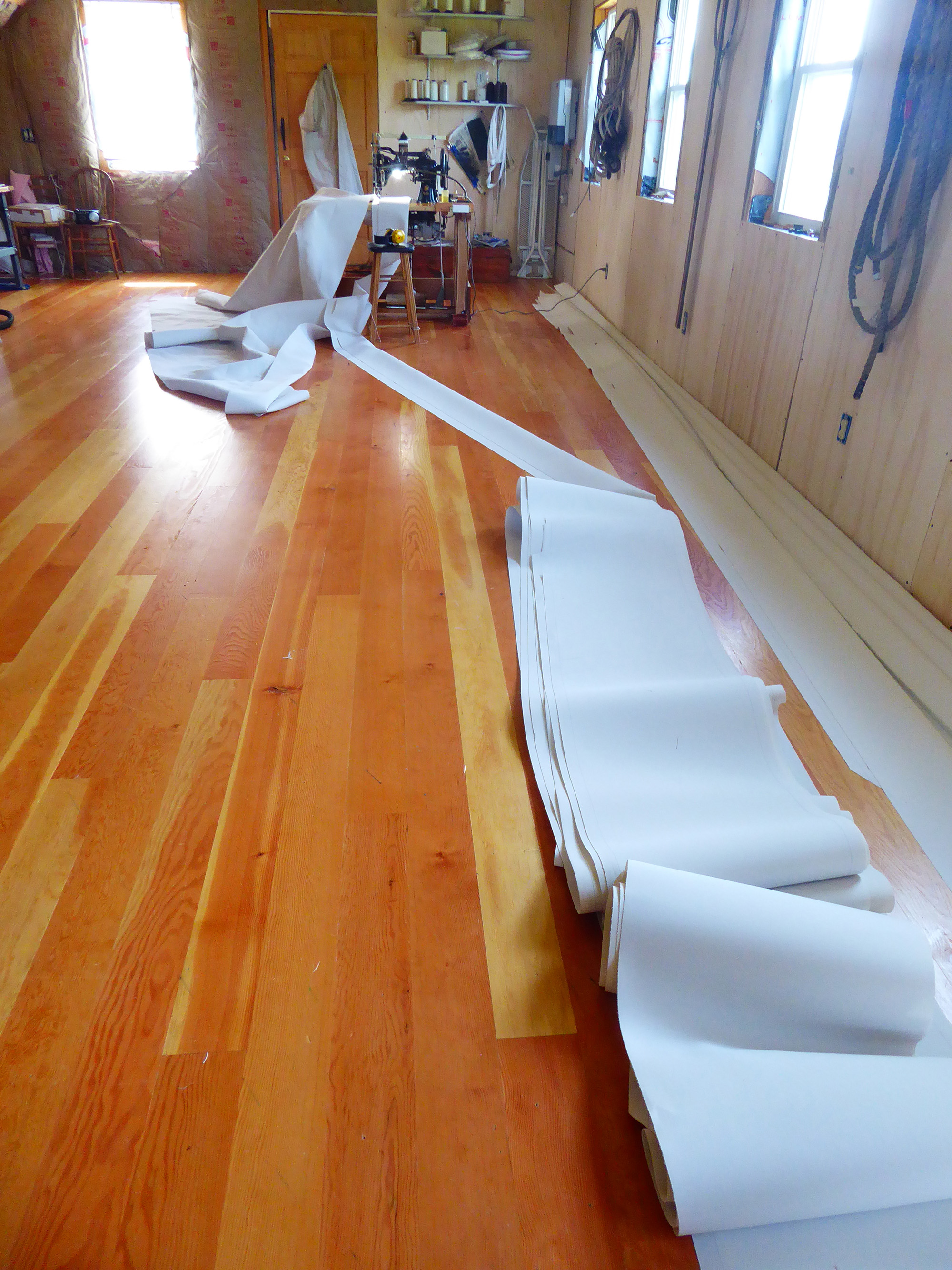
Edna Lockwood craned to marine railway
On Thursday, Aug. 2, 1889 bugeye Edna Lockwood was craned on to CBMM's marine railway, from which she will be relaunched in October. Shipwrights and apprentices will finish her restoration with the National Historic Landmark up on the railway, and she will go back into the Miles River at CBMM's OysterFest on Saturday, Oct. 27, 2018. For tickets and details, visit cbmm.org/oysterfest.









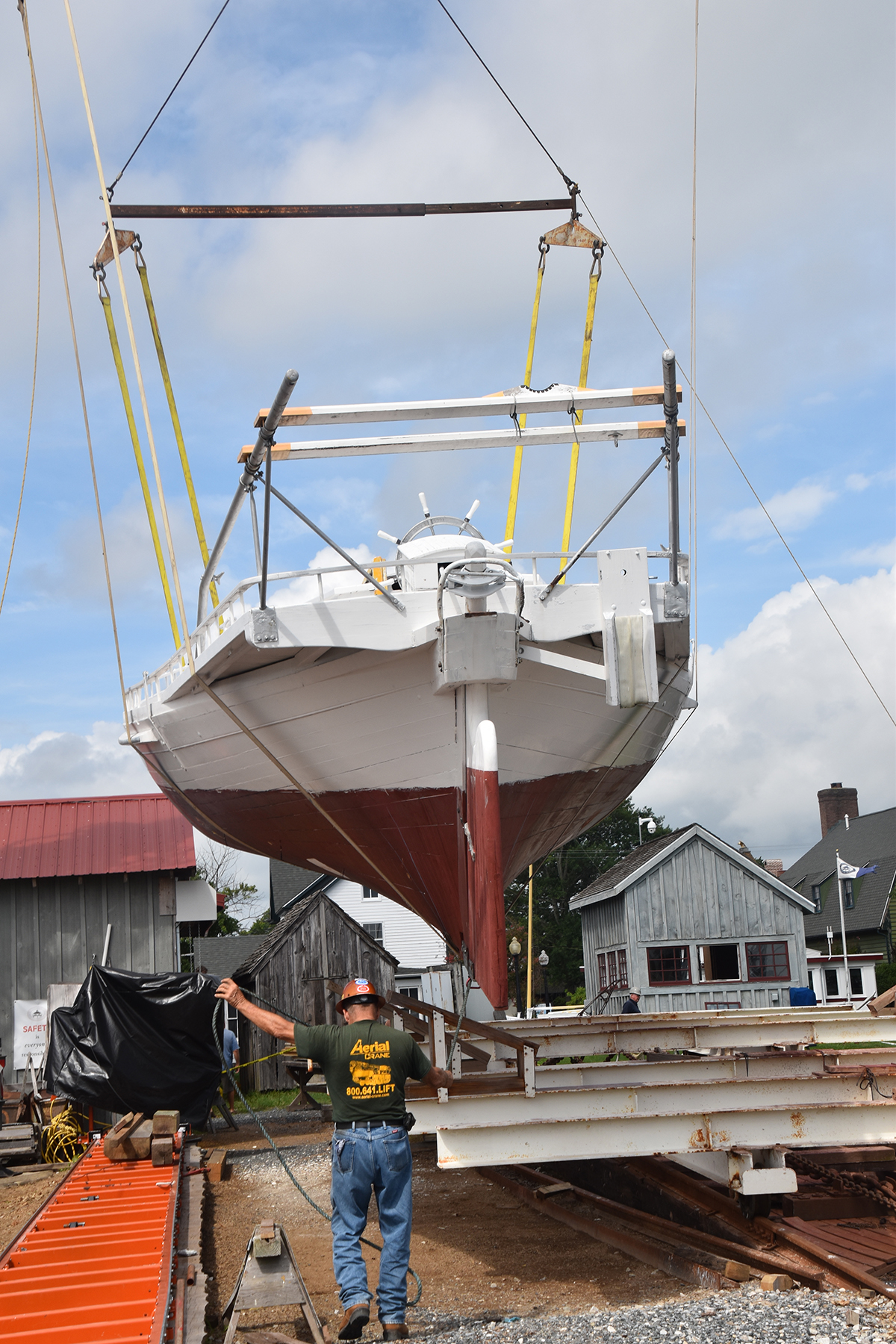



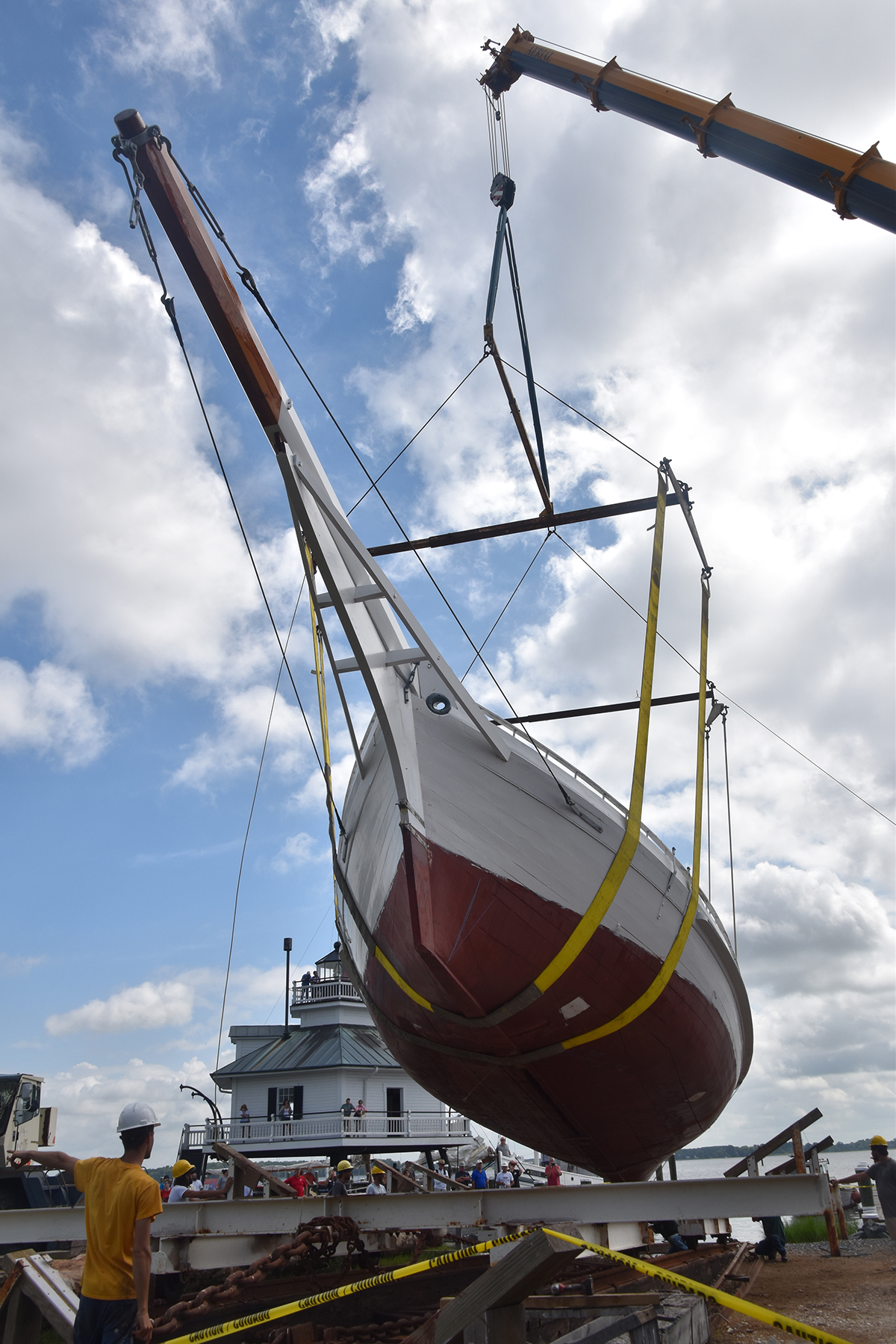
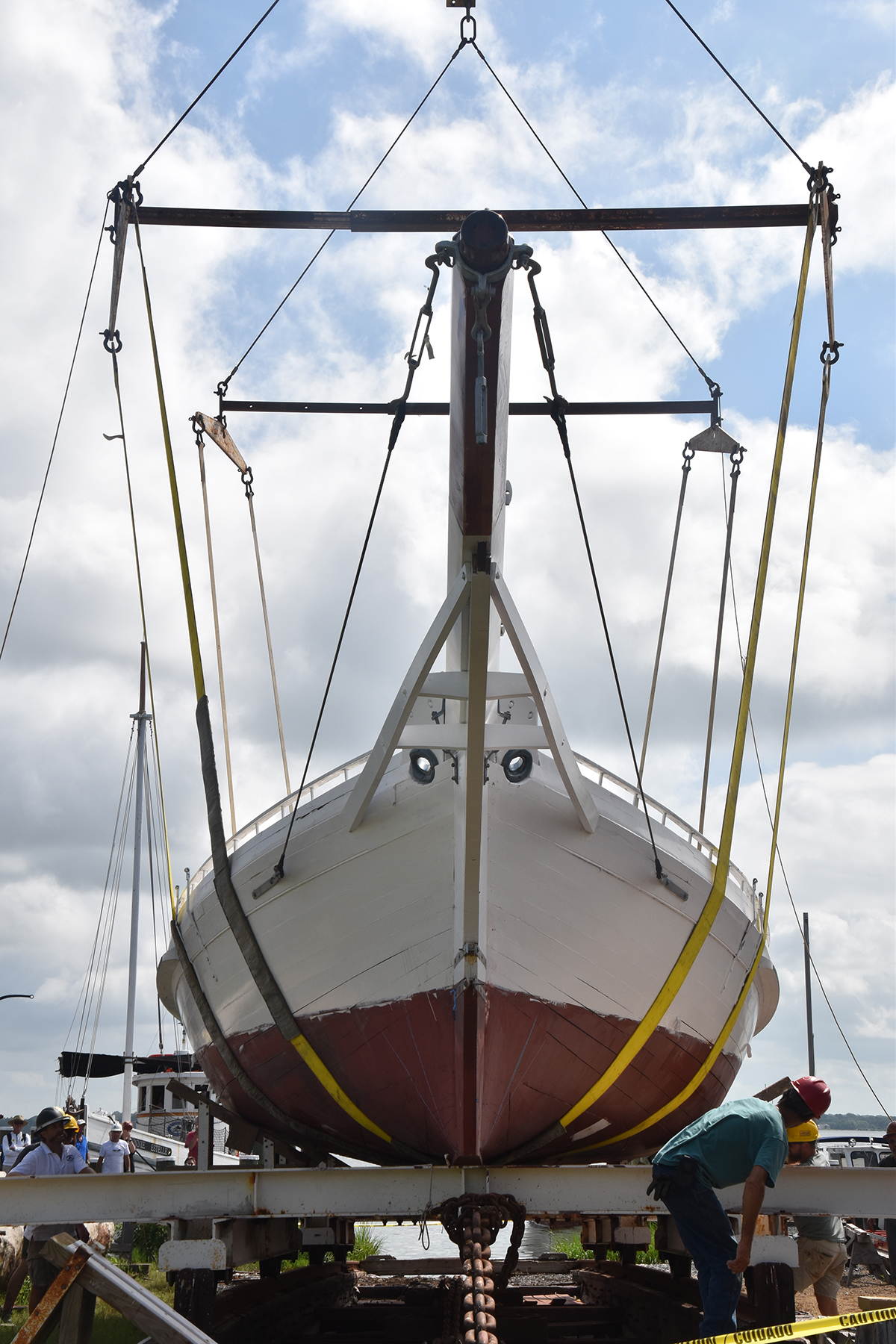
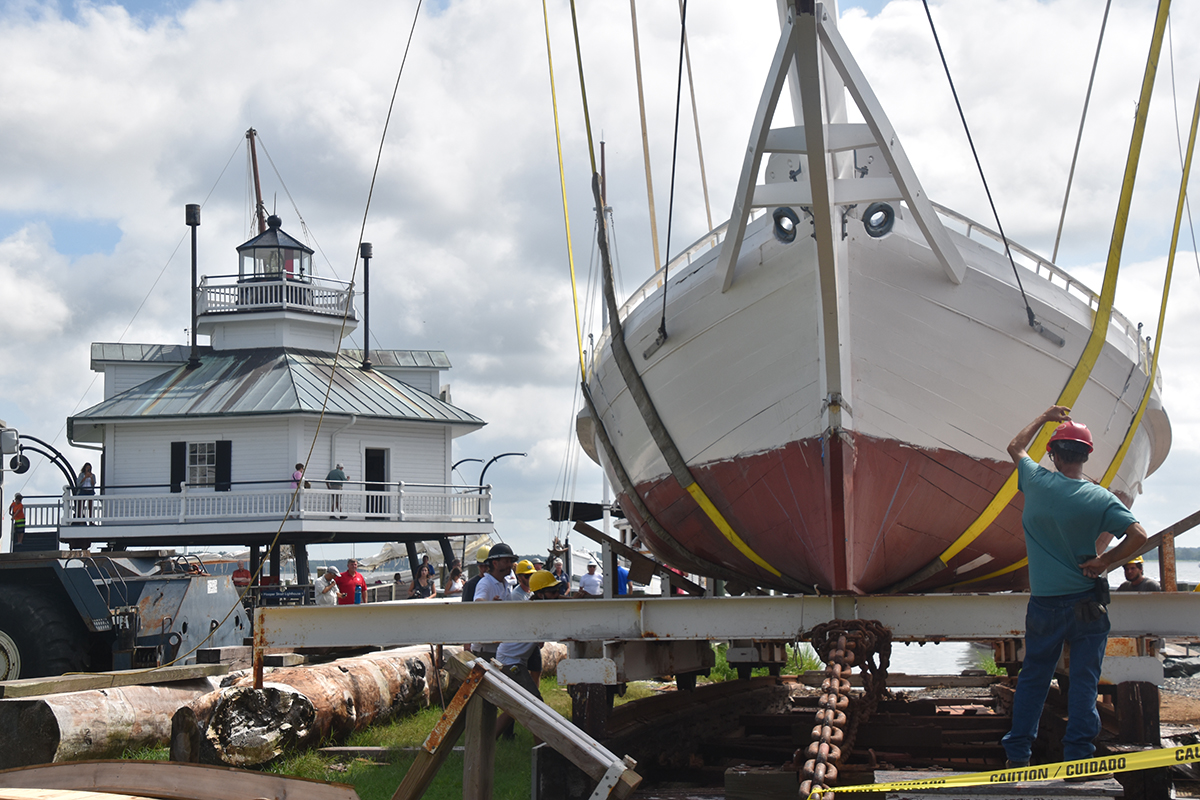
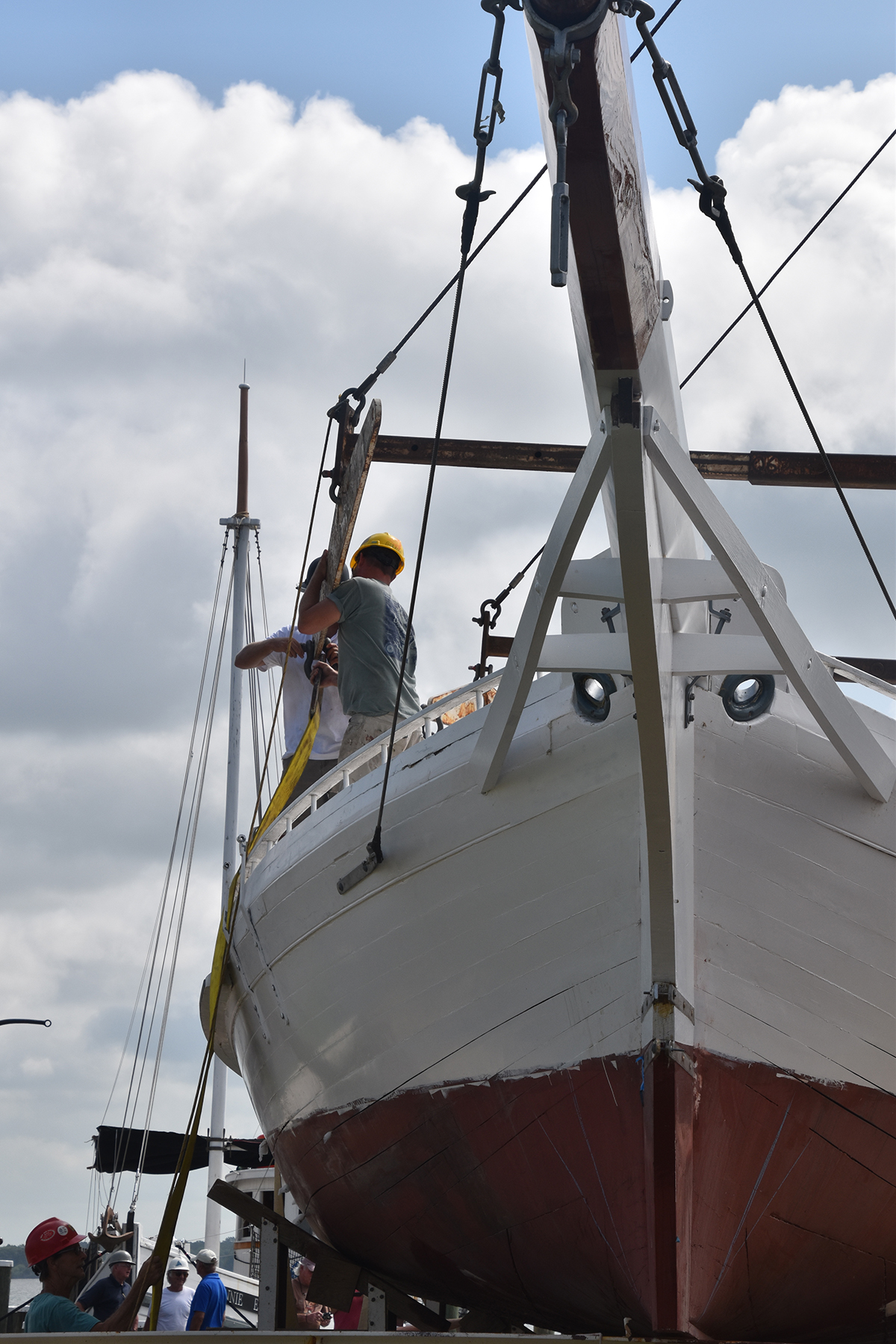
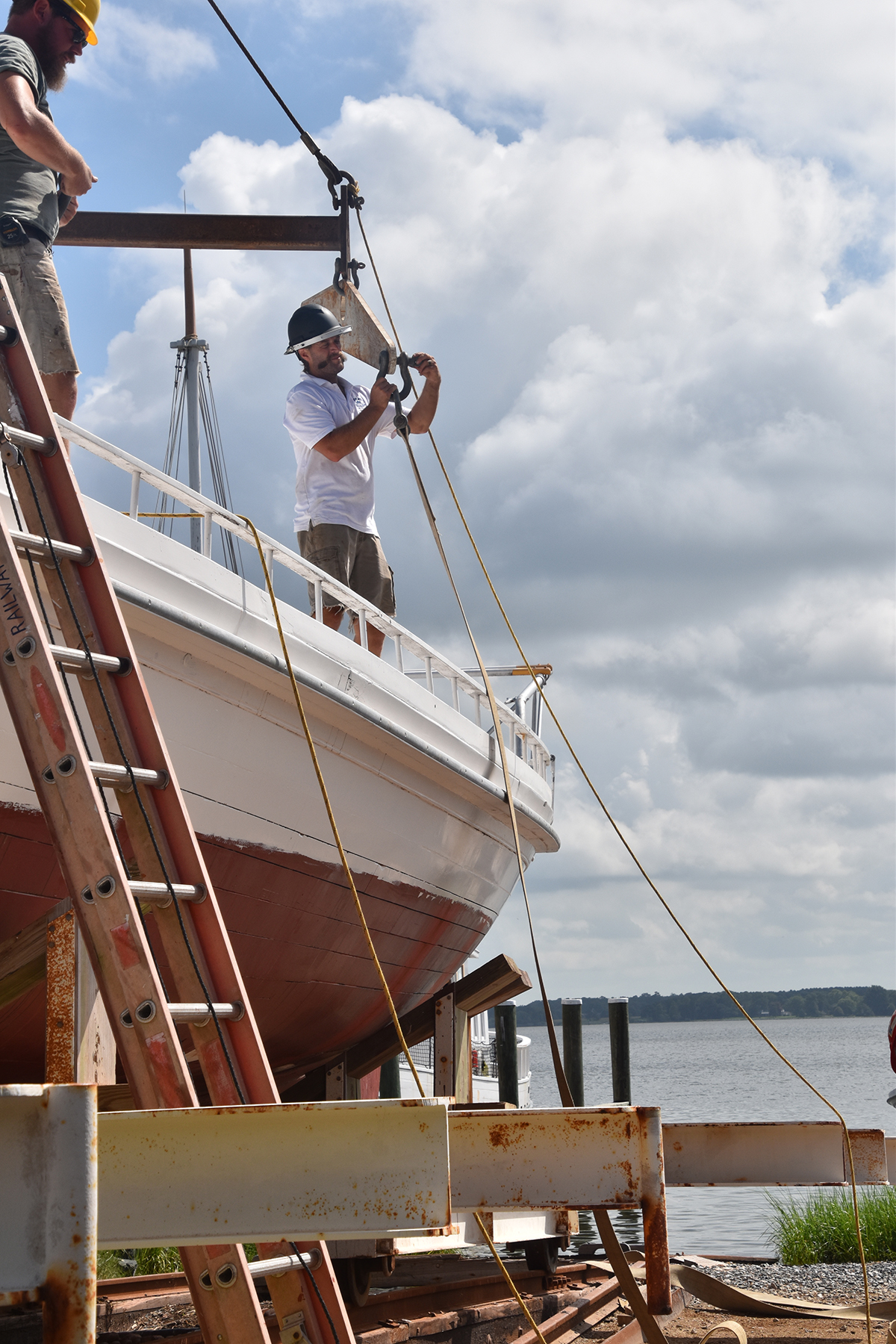
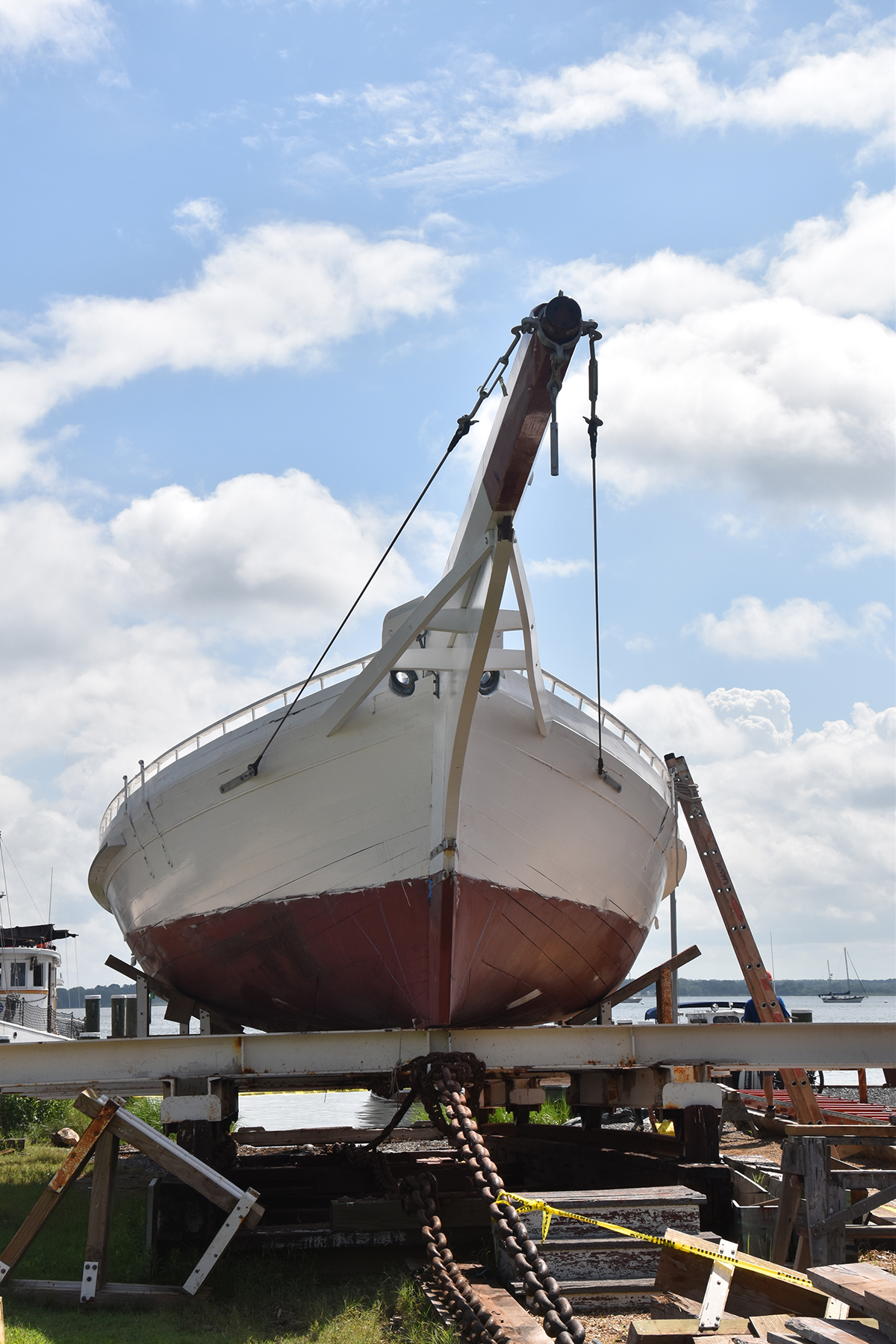
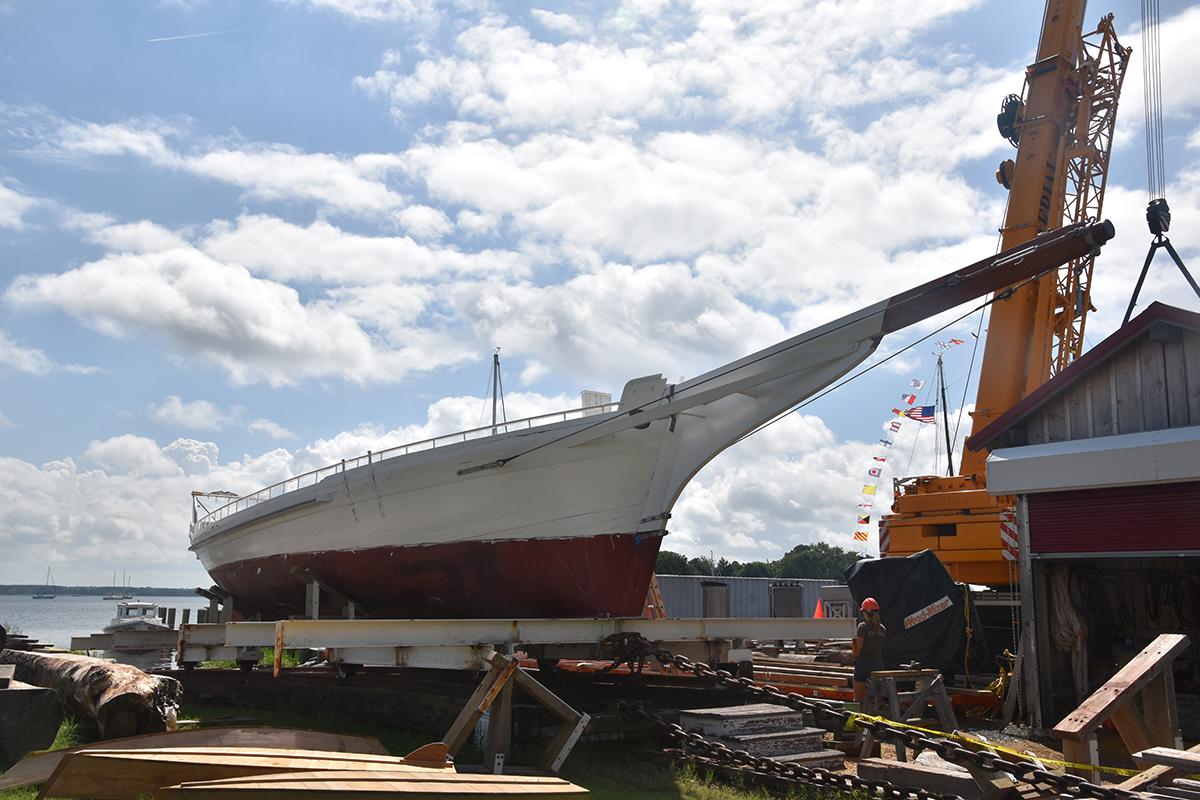
Flip through to see photos from Edna's move!
Shipwrights prepare Edna Lockwood for October relaunch
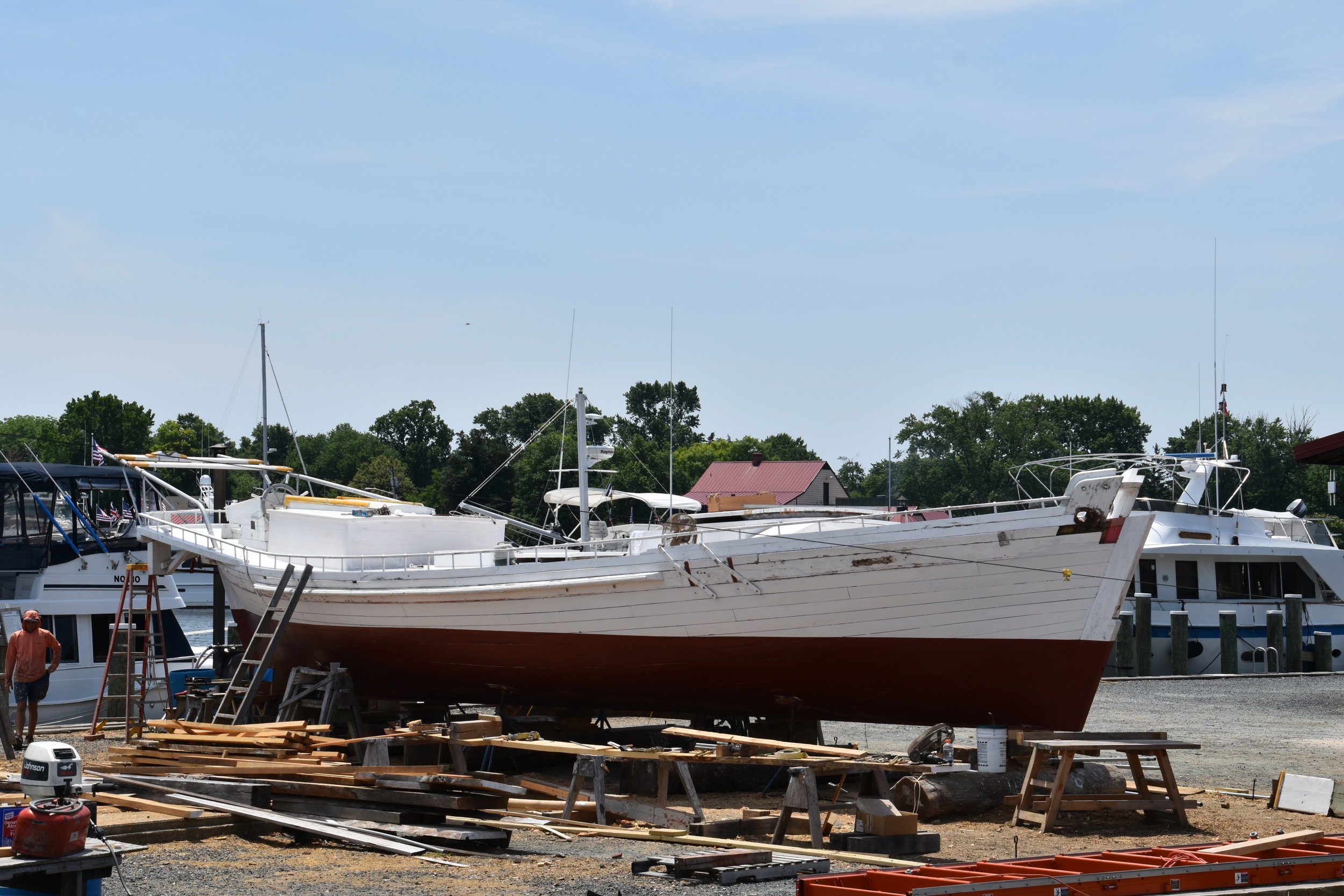
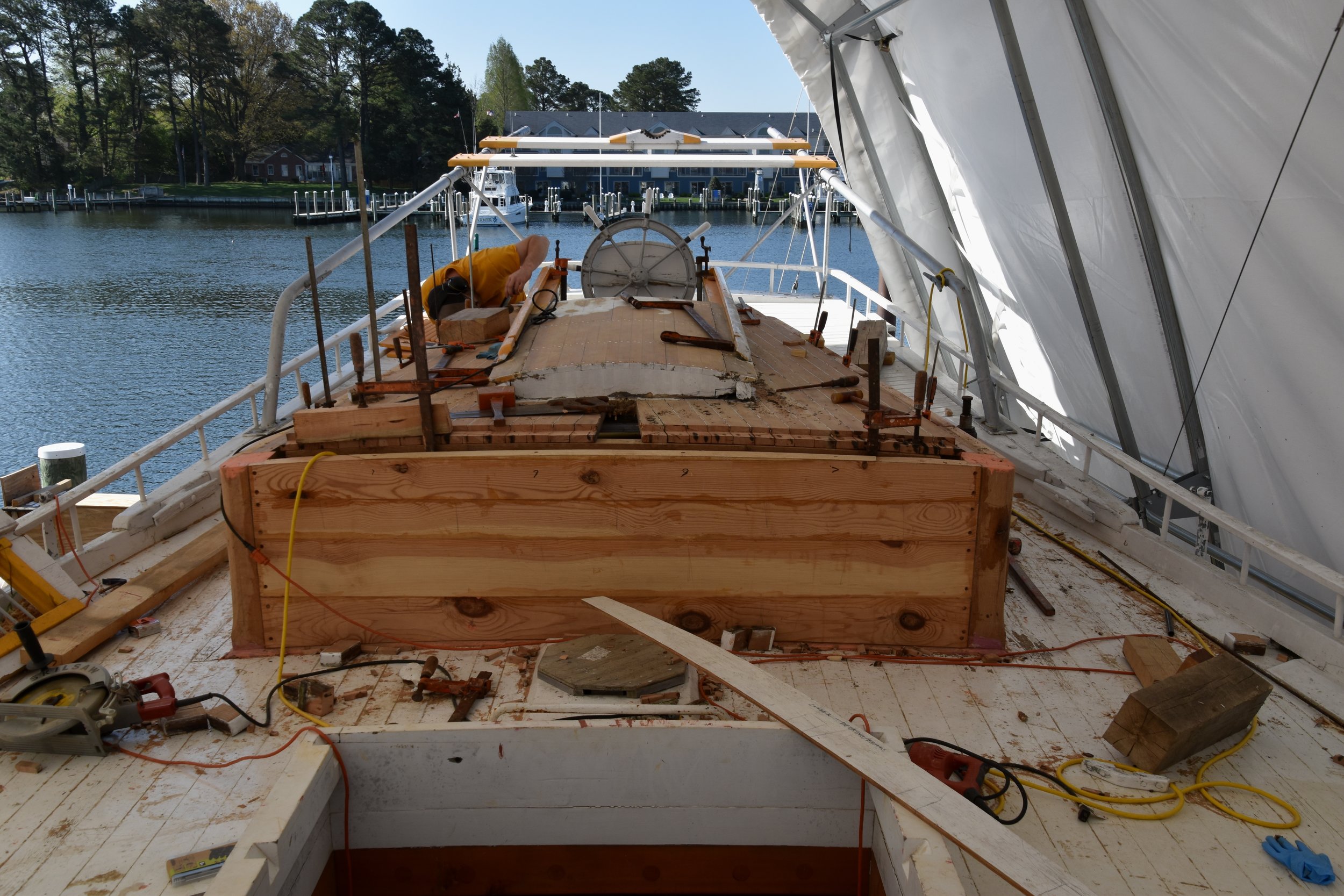
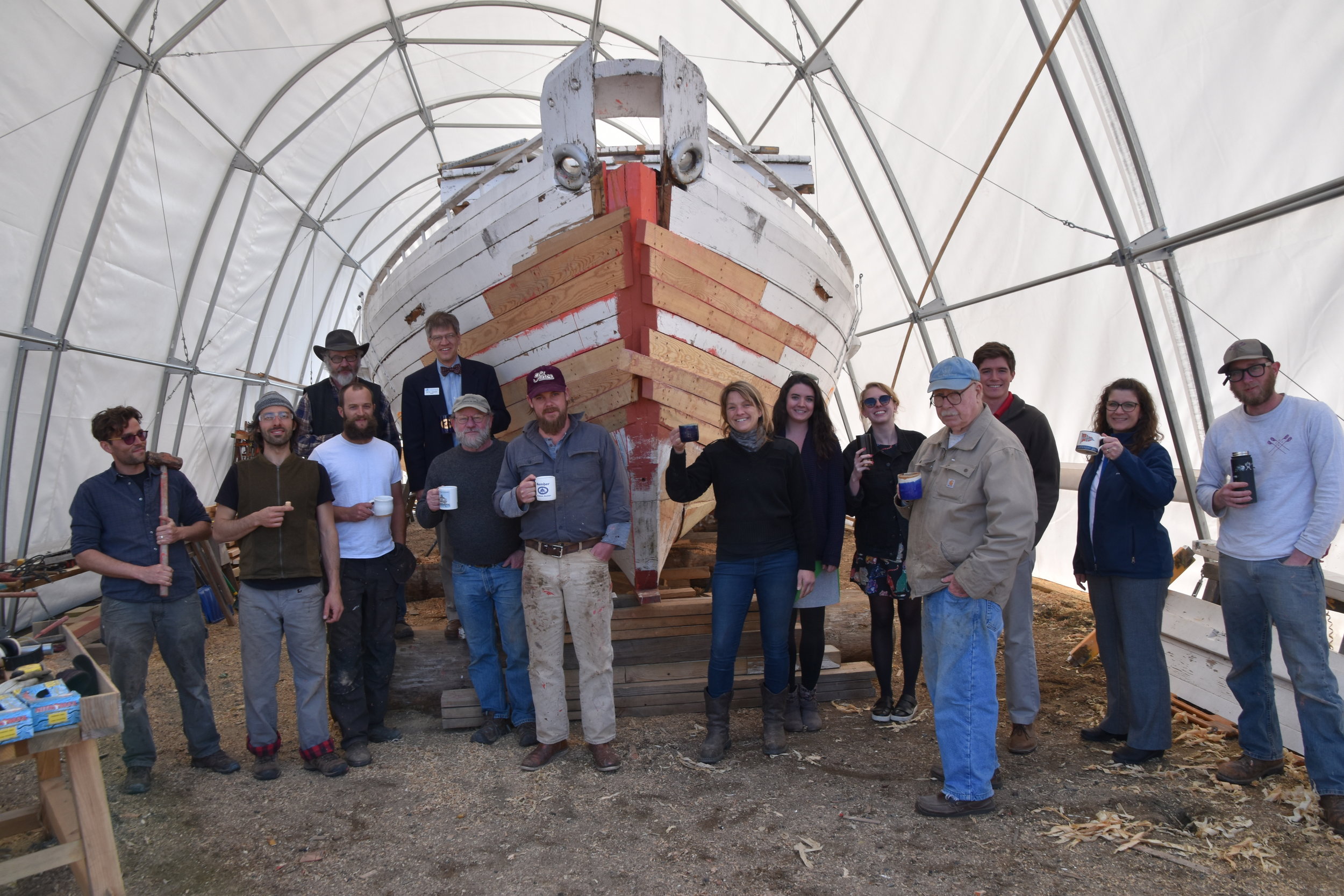
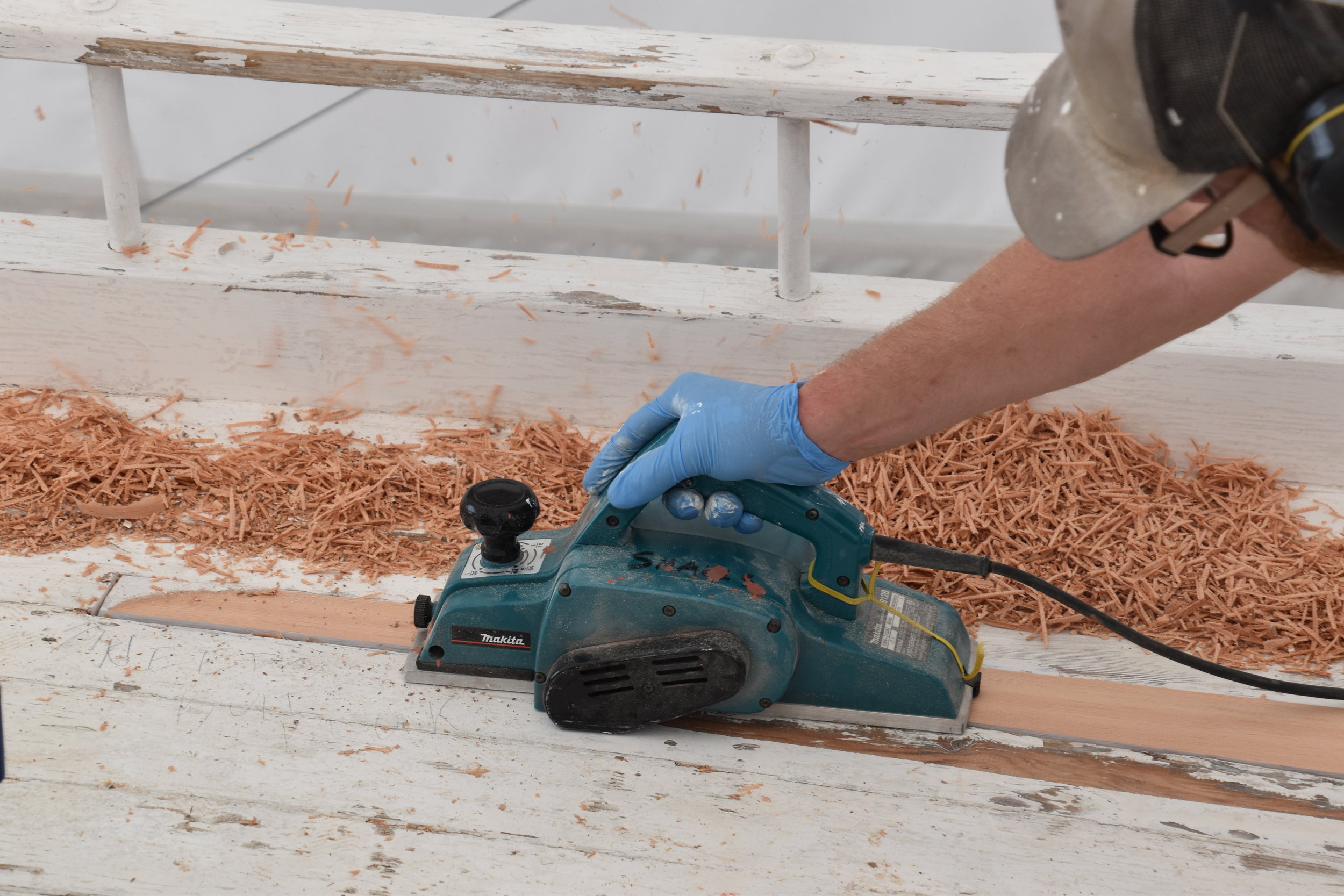

Chesapeake Bay Maritime Museum Shipwright Joe Connor reports final preparations are underway on the restoration of Edna E. Lockwood, with the 1889 bugeye and National Historic Landmark set to relaunch at CBMM’s OysterFest on Saturday, Oct. 27.
This spring, Edna’s hull was finished and her whiskey plank installed. Since then, attention has turned to the deck, where the main and cargo cabins have been rebuilt. Most of the deck planking was in good shape, so shipwrights only needed to replace roughly 12 feet of her king plank and less than 10 percent of her deck planks. The deck has been caulked (with oakum on cotton), and coats of paint are starting to build up.
The hull has also been faired, and the first coats of paint applied. The outer stems on both bow and stern have been fabricated and installed. In the coming months, shipwrights and apprentices will be rebuilding the gammon knee (chicken beak), caulking planks, and installing the rudder, steering gear, stepping masts, and rigging.
Above Edna’s log section sits 2-inch yellow pine planking fastened to 5-inch double-sawn white oak frames. The existing fasteners were steel square boat nails, which are very effective but are not conducive to future restoration work, as they are permanently installed. For this reason, it is common CBMM practice to fasten with Frearson head bronze screws for ease of maintenance.
Since 2016, the team has been restoring CBMM’s Queen of the Fleet by replacing her nine-log hull, in adherence to the Secretary of the Interior’s Standards for Historic Vessel Preservation. Shipwright apprentices working on the project are generously supported by the Seip Family Foundation, and RPM Foundation.
Edna Lockwood: A look back at spring 2018
Now that we're officially in summer 2018 and nearing the final phases of the Edna Lockwood restoration at the Chesapeake Bay Maritime Museum, take a quick look back with us at the sights and sounds from the shipyard this past spring!
A Perspective on Edna E. Lockwood
Listen to CBMM Shipwright Joe Connor talking about the Edna E. Lockwood project. Documentary film produced by Ft. Meade Defense Information School's Broadcast Communications Specialist students, with special thanks to Airman First Class Kaitlyn Britton, Petty Officer Christopher Gaines, and Sergeant Daniel Ward.
Edna Lockwood — Winter 2018 Progress Update
With spring approaching, we asked Chesapeake Bay Maritime Museum Shipyard Manager Michael Gorman to look back on the Edna Lockwood restoration, and what his team has been up to over the past few months.
Winter brings progress to CBMM's Edna Lockwood restoration
Chesapeake Bay Maritime Museum Shipyard Manager Michael Gorman reports much work has been done over the winter on the log-hull restoration of Edna E. Lockwood. Queen of CBMM’s historic fleet of Chesapeake boats and a registered National Historic Landmark, the 1889 log-bottom bugeye is the last of her kind and set for re-launch at CBMM’s OysterFest in St. Michaels, Md. on Saturday, October 27, 2018.
Edna’s new log bottom has been permanently fastened to the original topsides with bronze bolts, each made from scratch out of ½-inch bronze rod, with soldered nuts and washers forming the head. CBMM shipwrights and apprentices will fabricate more than 300 bolts when the restoration is complete later this year.
Shipwright James DelAguila led new shipwright apprentice Zach Haroth in fabricating Edna’s new centerboard case. The case’s 4-inch thick sides were pinned every 18-inches with bronze, in the same manner that Edna’s logs are held together. The inside of the centerboard case was also lined with more than 200-feet of 16-gauge copper, for antifouling and preservation purposes.
Seip Family Foundation second-year apprentices Michael Allen and Spencer Sherwood have teamed up to install Edna’s new double-sawn frames and mast steps. Made of White Oak and bolted with custom bronze bolts, the frames and steps keep the masts in place and handle tremendous loads when the bugeye is underway.
Planking Edna has begun in earnest—all rotten hood ends have been staggered back, and the inner stem and sternpost replaced—thus the gap between old and new will be closed. Shipwright Joe Connor will be handling the stern, while Gorman will plank the bow, with the work of the two meeting in the middle. All new planking will be sawn out of the leftover Edna logs.
With the end in sight, Edna’s new sails have been ordered, with an estimated arrival date of August 1. Traditional Rigging Co. of Appleton, Maine, has been selected for their specialty in period sailmaking and handwork. Traditional Rigging Co. has also agreed to document the sailmaking process, with photos and progress reports posted on ednalockwood.org.
Next up for the team is constructing new cabin houses and hold hatches, with all work being done in full public view, now through October. A new deck beam will need to be made and king plank reinstalled, now that the centerboard case is completed. Once the planking and final fairing is completed, sanding and painting will finish off the project.
Built in 1889 by John B. Harrison on Tilghman Island for Daniel W. Haddaway, Edna Lockwood dredged for oysters through winter, and carried freight—such as lumber, grain, and produce—after the dredging season ended. She worked faithfully for many owners, mainly out of Cambridge, Md., until she stopped “drudging” in 1967. In 1973, Edna was donated to the Chesapeake Bay Maritime Museum by John R. Kimberly. Recognized as the last working oyster boat of her kind, Edna Lockwood was declared a National Historic Landmark in 1994.
“This type of boatbuilding is specific to the Chesapeake Bay,” said CBMM Chief Curator Pete Lesher. “Just as Native American dugout canoes were formed by carving out one log, a bugeye's hull is unique in that it is constructed by hewing a set of logs to shape and pinning them together as a unit. Through October, museum guests will have incredible opportunities to watch the restoration progress and to see a boat built in a way you can find nowhere else, and in full public view.”
To learn more, visit the Chesapeake Bay Maritime Museum on the Miles River in historic St. Michaels, Md., or at cbmm.org.
Edna Lockwood - Fall 2017
Miss out on any of the action from the shipyard this fall? Take a look and listen to see where we're at in the historic restoration of 1889 bugeye Edna Lockwood! She re-launches at the Chesapeake Bay Maritime Museum's OysterFest on Oct. 27, 2018.
Beams Away!
The steel beams that were holding Edna E. Lockwood's old topsides above her new hull, generously loaned to CBMM by Chesapeake Shipbuilding of Salisbury, were removed November 29. The historic bugeye is now back together again and ready for the craftmanship that will return her status as queen of the fleet at the Chesapeake Bay Maritime Museum.
Shipwrights combine hull, topsides of bugeye
Chesapeake Bay Maritime Museum Boatyard Manager Michael Gorman reports the historic restoration of Edna E. Lockwood is right on schedule, with her new hull now attached to her existing topsides. The 1889 bugeye and National Historic Landmark is set to launch at CBMM’s OysterFest 2018, scheduled for Saturday, October 27.
Fall and winter saw a very active shipyard at CBMM, with shipwrights and apprentices going through several steps to combine the two pieces of the boat. Her outer stems were removed, shims were added to make up for hidden material behind frames, plank lines were mapped, and the hull was jacked up to its final height on the hard. Additionally, centerboard posts were milled and fastened, bronze stock was used to make custom bolts to fasten the new hull, and Edna’s old hull was moved to storage, with the intention of the piece eventually being a permanent exhibition. They will move on to planking next, and will be replacing the cabin house.
The restoration team is reviving CBMM’s queen of the fleet Edna Lockwood by replacing her nine-log hull, in adherence to the Secretary of the Interior’s Standards for Historic Vessel Preservation. Shipwright apprentices working on the project are generously supported by the Seip Family Foundation and the RPM Foundation. All work takes place in full public view on CBMM’s waterfront St. Michaels campus. To learn about the project, visit ednalockwood.org. For more on CBMM, visit cbmm.org.
November update on Edna Lockwood
Listen in as Chesapeake Bay Maritime Museum's Shipyard Manager Michael Gorman shares an update on the Edna Lockwood restoration project with staff.
Shipwrights start next phase of Edna Lockwood restoration
Chesapeake Bay Maritime Museum Boatyard Manager Michael Gorman reports that a major step has been made in the historic restoration of 1889 bugeye Edna E. Lockwood, with her existing topsides lifted by crane to sit directly above her new nine-log hull. Edna Lockwood represents the last of her kind, as the oldest historic log-hull bugeye still under sail.
In mid-September, the topsides were successfully transferred to sit just above the new hull, which shipwrights finished shaping earlier this year. At the same time, Edna’s original 1889 hull was moved to the other side of CBMM’s campus, where it will eventually be put on display.
The next phase in the restoration will see shipwrights begin the process of marrying the two sections of the boat, and jacking the bottom up to meet frames. New stems, hatches, additional structure will also be installed this fall, and sails will be sent out to have new ones made.
The team is restoring CBMM’s queen of the fleet and National Historic Landmark Edna E. Lockwood by replacing her nine-log hull, in adherence to the Secretary of the Interior’s Standards for Historic Vessel Preservation. Shipwright apprentices working on the project are generously supported by the Seip Family Foundation and the RPM Foundation. All work takes place in full public view through 2018, when Edna will be placed on the marine railway and launched at CBMM’s OysterFest in October.
Edna E. Lockwood: Top to Bottom!
For the past four decades, the Chesapeake Bay Maritime Museum in St. Michaels, MD has been maintaining and restoring the historic 1889 bugeye, Edna E. Lockwood. September 20, 2017 was a banner headline day in that process. Edna's hull, which was restored at the museum in the late 1970s, was taken off her original 128-year-old bottom and put atop a new bottom built by shipwrights at the museum. The old bottom will be on permanent display at the museum. Edna's restoration will continue until the fall of 2018 when she will set sail again during Oysterfest.
Video by Sandy Cannon-Brown
Summer 2017 in the Boatyard
Press play to experience the sights and sounds of the boatyard during summer 2017, as shipwrights and apprentices continue work on the historic restoration of 1889 log-hull bugeye Edna Lockwood.
Edna’s new hull takes shape
Chesapeake Bay Maritime Museum Boatyard Manager Michael Gorman reports work continues on the historic restoration of 1889 bugeye Edna E. Lockwood, with each of the nine-logs making up her new hull pinned together and shipwrights fitting chunks in her bow and stern over the summer. Edna Lockwood represents the last of her kind, as the oldest historic log-hull bugeye still under sail.
It was a busy spring in the boatyard, with the hull flipped via crane in April and the two wing logs pinned to the rest of the assembled hull in May. In July, the hull was moved around the boatyard to sit directly next to Edna E. Lockwood in preparation for the next steps in her restoration. In September, Edna’s topside will be moved to the new hull so shipwrights can begin to marry the two, an important step in the restoration project. New stems, hatches, additional structure will be installed this fall, and sails will be sent out to have new ones made.
The team is restoring CBMM’s queen of the fleet and National Historic Landmark Edna E. Lockwood by replacing her nine-log hull, in adherence to the Secretary of the Interior’s Standards for Historic Vessel Preservation. Shipwright apprentices working on the project are generously supported by the Seip Family Foundation and the RPM Foundation. All work takes place in full public view through 2018, when Edna will be placed on the marine railway and launched at CBMM’s OysterFest in October.
